The following is Part 2 of a 3-Part series reporting on the 26 presentations at the DirectEmployers (“DE”) Annual Meeting & Conference (DEAMcon24) of Members and the public. DE published the first installment on Monday, April 15, and will post the third installment on Monday, April 29.
What follows are summaries and selected highlights from each of the extensive presentations.
Story references are to DE’s OFCCP Week in Review Blog.
DE Members may view the presentation slides for all the DEAMcon24 sessions at this link: https://deamcon.org/slides/
- Day Two of DEAMcon24 Began with a Nod to How a Diverse Workforce Shaped WWII & Led to Current Federal Requirements
- “It Takes a Village” – Strategies to Effectively Leverage Internal & External Resources to Bring your DEIB Program to Life
- Bogged Down in the Bayou: Don’t Get Buried by the 10 Biggest AAP & Discrimination Law Problems
- Recruit Rooster Showcased “Striking the Right Chord in Recruitment”
- Abt Associates Discussed its Journey to Achieve a Successful Professional Services Internship Program
- Petersen Provided Insights on Creating a Socially Just Recruitment Strategy
- Unlocking the Power of Apprenticeships & HBCUs to Build a Diverse Talent Pipeline
- Practical Considerations of Artificial Intelligence: What No One Tells You
- A Recruiter’s Role in Compliance: Validating Job Requirements & Impacts on Hiring Processes
- Partners in Talent Acquisition: WorkSource Business Services & Statewide Support
- Bev Harp Explained the Neurobiology of Autism and Provided Many Practical Tips to Recruit and Interview Autistic Applicants for Employment
- Panel Discussion: Steering the NLx
- Long’s Keynote: Connecting the Workplace & Life Through FUN
Day Two of DEAMcon24 Began with a Nod to How a Diverse Workforce Shaped WWII & Led to Current Federal Requirements
 Day Two of DEAMcon24 began with DE Executive Director Candee Chambers providing some insight into Wednesday night’s off-site event at the National World War II Museum, where attendees enjoyed entertainment featuring the Victory Belles and a private outdoor viewing of an exclusive short film featuring the reading of authentic letters written between soldiers and their families. She noted that the museum is located in New Orleans because the city was home to Higgins Industries. “That small boat company produced an ingenious collection of amphibious boats,” she said. These boats, known as Higgins Boats, “delivered masses of servicemembers and equipment safely to the shore eliminating the need for harbors,” she explained.
Day Two of DEAMcon24 began with DE Executive Director Candee Chambers providing some insight into Wednesday night’s off-site event at the National World War II Museum, where attendees enjoyed entertainment featuring the Victory Belles and a private outdoor viewing of an exclusive short film featuring the reading of authentic letters written between soldiers and their families. She noted that the museum is located in New Orleans because the city was home to Higgins Industries. “That small boat company produced an ingenious collection of amphibious boats,” she said. These boats, known as Higgins Boats, “delivered masses of servicemembers and equipment safely to the shore eliminating the need for harbors,” she explained.
Especially pertinent to the professionals attending the conference, the museum’s website also notes that:
“A small workforce of only 75 workers in 1938 grew to over 20,000 by 1943. The Higgins workforce was the first in New Orleans to be racially integrated. His employees included undrafted white males, women, African Americans, the elderly and handicapped persons. All were paid equal wages according to their job rating. They responded by shattering production records, turning out more than 20,000 boats by the end of the war.”
During a presentation later that morning, attorney John Fox added some additional insight. In June of 1941, based on advocacy from civil rights groups, President Roosevelt issued Executive Order (“EO”) 8802, banning discriminatory employment practices – based on race, creed, color, or national origin – by federal agencies and all unions and companies engaged in war-related work.
“That was the first Presidential Executive Order requiring nondiscrimination” on the basis of race, color, creed, and national origin, John pointed out, adding that it did not include sex. He added that “sex” as a protected category was not included in President Johnson’s initial version of EO 11246 issued in 1965, “but that’s another story.” President Johnson amended EO 11246 in 1967, via EO 11375, to include “sex” as a protected category. In any event, EO 8802 led to Higgins Industries’ anti-discriminatory employment policies, he said, noting the straight line between EO 8802 and EO 11246.
“It Takes a Village” – Strategies to Effectively Leverage Internal & External Resources to Bring your DEIB Program to Life
Jeremy Mancheski, President and founder of OutSolve, moderated an expert panel discussion that delved into the intricate dance between recruitment and compliance. The panelists explored strategies for bridging the gap between HR compliance and talent acquisition. To facilitate this discussion, Mark Booker, Director, Marketing & Sales at GoodGames, operated a game format that allowed the audience to submit questions to the panelists by using an app via a QR code shared with the audience. The app provided a chat function where the audience could ask questions and share comments with the panelists in real time. This allowed the panelists to continue their conversation undisrupted. Below are some highlights of that conversation.
The featured panelists were:
- Rob Arndt, founder & CEO of BufferSprings;
- Momolu A. Cooper, Director of Operations at OutSolve;
- Tiffany Meehan Vice President of Marketing at Inclusively; and
- Mikey Meagher, Manager of Diversity, Equity, and Inclusion Strategies at DE.
Self-identification & Disclosure of Accommodation Needs
 Audience question: “How can companies create a work culture where people feel comfortable to disclose needs, access necessary accommodations, and contribute their unique perspectives and talent to the organization without fear of stigma and discrimination?”
Audience question: “How can companies create a work culture where people feel comfortable to disclose needs, access necessary accommodations, and contribute their unique perspectives and talent to the organization without fear of stigma and discrimination?”
Tiffany: “I think the biggest thing is definitely creating that space [with] your policies, your language, your messaging, [and] your marketing … Companies [should be] upfront with what they can offer,” including ensuring that their websites are accessible.
Audience question: “What are best practices for integrated personalized workspace accommodations into the talent acquisition process ensuring that the unique needs of all employees including those with disabilities and veterans are met from day one?”
Tiffany: “Being upfront about what you can provide. [For example, have a meeting with a worker and] asking them upfront, ‘Do you need accommodations for this?’ And they’ll tell you. Someone who needs an ASL interpreter will probably have someone they recommend already.”
Jeremy: “Remove workplace rules [and other barriers] that aren’t required to complete the job. Do so for all workers. Often barriers are not intentional, they are just dated. In our business working with contractors preparing and supporting affirmative-action plans. We ask, ‘How often do you really look at those basic qualifications?’”
Question: “How do we create that buy-in?”
“I encourage this thinking outside the box,” Momolu said. “In that interview process, before someone comes on board, we at OutSolve literally ask, ‘How do you work, and how do you work best?’” This conveys to the worker that the employer wants to understand their accommodation needs and is “setting them up for success on day one.”
Question: “How can employers communicate it’s a safe environment to self-identify?”
Rob: “There has to be a ‘what’s in it for me’ for those individuals on the other end of it. We’re asking you if you are a veteran because we are creating leadership and development tracks for veterans specifically are trying to get more veterans into the organization and we want to find out how you ended up here … When I was asked this question coming into my first time in civilian employment coming out of the Marine Corps, I said why are they asking me this? Are they going to volunteer me to march in a parade and be the token veteran on Veterans Day? I don’t know what you’re doing with the data or information. … [Moreover], keep educating them once they’re in and it’s not just an onboarding process, it’s ongoing.”
Both Rob and Tiffany pointed out that a person can become disabled at any time. Thus, an employer needs to continue requesting self-identification to stay on top of the needs of its workforce.
Question: “What’s the best practice for trying to get workers to self-identify their status as a member of a protected category?”
Momolu: “When was the last time you actually applied for a job at your organization? I think most individuals who apply for a job are using their smartphones or tablets and so forth. We found out that at one organization, while applying for their job through a smartphone, there was another window that opened up for the self-ID, and the applicants never got a chance to actually fill out the form. So, making sure that those forms are embedded in the processes may give you that opportunity for individuals to self-identify.”
Employee Resource Groups
Question: “How can large companies ensure their Employee Resource Groups [“ERGs”] are not only aligned with the company’s overall strategic goals but also contribute to tangible outcomes in diversity, equity, and inclusion?”
Mikey: “Employee Resource Groups are vital to a company’s success. You can utilize your resource groups in so many different ways. Even getting new talent through the door. During that interview process, involve your employee resource group. That’s a best practice that you can take away. Have that candidate come in and know that there’s diversity in support right away. If they get this job, they know that they have a place they can go to request accommodations, and right from the start.”
Momolu noted it is important for ERGs to be welcoming and not cliques: “Make sure as you develop your ERG groups, that you encourage everyone, regardless of whether or not you meet the criteria, that you are actually invited to participate.”
Rob: “Your ERG has to have purpose. It’s not just another club… If they’re not purpose-driven, you’re not going to get engagement… [For example,] with veteran ERGs, the purpose is that veterans know, and more importantly trust, other veterans… Build ERGs with a purpose, that way, when that individual – whether it’s a woman, person of color, person with disabilities, or veteran – checks in, they see representation. They see themselves. They see what they aspire to be in five years of their leaders and managers and see representation across the board within that ERG.”
Question: “What is your thought on senior leadership joining ERGs?”
Momolu: “This is where you actually hear what’s going on in your organization and identify deficiencies and opportunities to improve personal lives. There’s one organization we help, a major healthcare organization out of Michigan, and it’s on the schedule of their CEO and top executives … that they attend every ERG meeting and […] write a memo [to disseminate to all] their employees about how it was, how it was engaging, and encouraging other members to join. It starts from the top. I doubt you’ll have pushback from the bottom.”
Special Concerns Involving Veterans
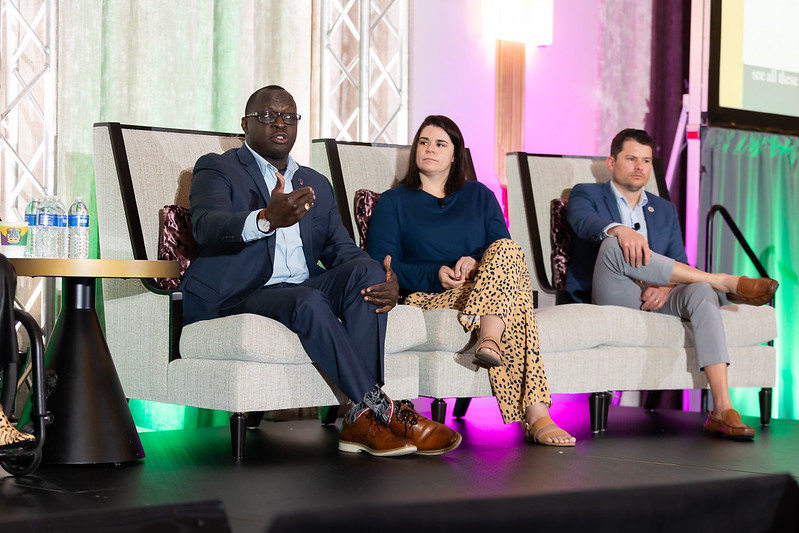 Question: “What resources and support systems can employers implement to create a mentally healthy workplace for employees who are veterans?”
Question: “What resources and support systems can employers implement to create a mentally healthy workplace for employees who are veterans?”
Rob: “We have people in the room right now who have been bit by a dog or who had a traumatic childhood that have PTSD, that have never worn a uniform … A lot of the stigma and biases around veterans comes from that PTSD stigma, [but] only 13 percent of veterans have been classified and diagnosed with PTSD so it’s not as widespread as we believe. … When dealing with those workforce challenges and resources we [have veterans who do not have PTSD that still] need mental assistance in some areas. It’s important for us to not just stigmatize veterans for that but to offer those things to all of our employees and let them know that these are okay to have … Right now, one in five people have a disability. However, when we look at our affirmative-action plans, our plans look like 3 percent have disabilities. So, the more that we make accommodations, the more that we make resources available to more people to help self-identify [and eliminate the stigma], the more people are going to come out … PTSD is not a veteran thing. It is a human thing.”
On the topic of transitioning military skills to civilian roles, Rob noted the enormous variety of military roles. “When you have military individuals, realize we are Swiss Army knives. We have been trained on different things so even if that veteran did something in the past they may want to do something else in their future. … Everything in the military translates to a civilian role, you just need to know what to call it and not have biases about who military people are. We don’t all blow stuff up and fight bad guys.”
Evaluating Effectiveness
Question: “What approaches can organizations use to accurately evaluate the effectiveness and influence of their DEI efforts promoting accountability and ongoing enhancement?”
Tiffany: “[At Inclusively,] we have this tool that not only stores the accommodations, but it shows employers and teams where people are requesting accommodations – what is working and also provides that space to give feedback. We love feedback. We think that companies should have surveys, anonymous surveys, all the time and schedule them regularly to get a temperature check on what’s going on . . . We have all of that in one platform.”
Increased Scrutiny on DEI
Jeremy asked the panel for their final thoughts, especially in light of the recent increased scrutiny on DEI.
Mikey: “If organizations are intentional about what they’re doing, that message should be spread through the rest of the organization and the employee’s experience. There are going to be barriers. There are always going to be barriers. But leadership is key. . . just keeping those communication lines open and available will at least keep the message from being lost during a time when there are barriers.”
Momolu: “I would say just be kind . . . If you think politics are not in your office, then your eyes are closed. People are not speaking, but they’re living . . . I would make sure as a headline comes out that you reiterate your commitment to your people. You confirm, and you take the time to reach out to each one . . . Just to check in and make sure everything is good based on the uncertain times that we are now dealing with. Check on your people.”
Tiffany: “Empathy is the biggest thing that we’ve seen in successful leaders. They don’t have to go through it, but they have to understand one disabled person is not the same as the next. And everyone needs kindness and understanding. It’s wanting to feel valued.”
Rob: “The word barrier in itself, we don’t have space for the work we do in this room. A barrier is a limitation. It’s a blockage. We’re looking for progress, and we know the people of progress, so barriers don’t have a place in the work that we do.”
Jeremy: “Simply ask, ‘How may I help you?’ I think communication is an amazing tool for leaders and talent acquisition, in the C-suite. You name it. Communication works. One of the comments earlier said my needs aren’t special. They’re human. I think everyone on the stage, everyone in this audience, and we can leave it with this final thought, I think all of us have some differences from each other. But as they say, we’re all more alike than different.”
Bogged Down in the Bayou: Don’t Get Buried by the 10 Biggest AAP & Discrimination Law Problems
What problems should federal contractors look for in preparing their organizations for possible OFCCP audits? DE Executive Director Candee Chambers and Attorney John C. Fox of Fox, Wang & Morgan P.C. retrieved and organized data from OFCCP enforcement efforts over the last twelve months. They combined this data, along with the many audit experiences of DirectEmployers Members and Fox, Wang & Morgan clients, to produce a succinct review of the top ten compliance obstacles OFCCP is currently preying upon in audits.
I. Job Groups Not Collecting “Similarly Situated” Employees
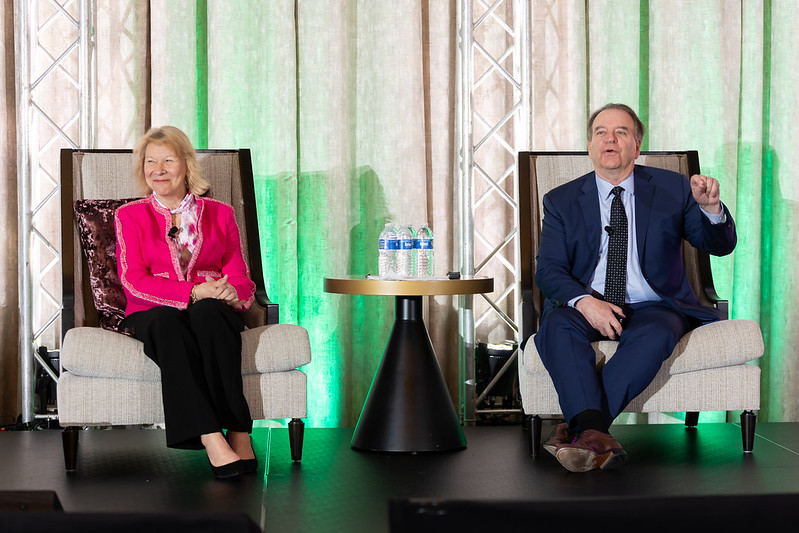 In legal terms, employees are “similarly situated” only if they share all the same “essential elements” of the job they perform, John said.
In legal terms, employees are “similarly situated” only if they share all the same “essential elements” of the job they perform, John said.
“This is something I run into all the time,” Candee said. “That means content of the job, opportunities for advancement, and wages.” If one worker could parachute into another’s job and do that job with minimal qualifications, then they should be in the same job group.
“What happens in the professionals job group is the one that’s really the nightmare because it encompasses so many different job requirements of so many different people across your organization,” Candee observed. “I strongly recommend you have upper, middle, and lower breakdowns,…because you can pick what that upper, middle, and lower pay band is.”
“Furthermore, you want smaller job groups…because [OFCCP] can do a whole lot more with your data if you have big job groups,” she added.
Affirmative Action Plans (“AAPs”) are “a legal tool, not just an HR tool,” John pointed out. Therefore, “‘similarly situated’ is critical language because every discrimination issue is based on a comparison of similarly situated people for compensation, for hire, for transfer, whatever it is, termination,” he said.
Moreover, “[t]he way the case law under Title VII has emerged, you have to be minimally qualified in every subcomponent essential element of the job,” John noted, adding that “‘close enough’ in horseshoes is not close enough in law.”
II. Inappropriate “Systemic” Compensation Analyses
“When you’re doing systemic compensation analysis, I will tell you this flat out. OFCCP always–100 times out of 100–does their analysis incorrectly, John said. Therefore, he advised the audience to pay close attention to their explanations. “To do comp, you need a lawyer . . . you need to have a Labor Economist, perhaps and you may need someone from HR depending on the kind of analysis. But you are going to first identify on the HR side all the “major” factors that affect pay,” he said.
He shared a slide outlining how to do this analysis with the following key points:
- Must analyze ALL “major” factors that affect pay (the top three are typically experience, longevity, and education, John and Candee said.)
- Must analyze and compare the pay of ONLY “similarly situated” employees
- Must analyze ONLY “pay decisions” and NOT the “current pay” amount
- May not apply class (or “systemic”) analyses to groups of similarly situated employees in groups too small to make for meaningful statistical analysis. Here is a “rule of thumb:”
- 30 or more similarly situated employees in the pool of employment decisions being compared; AND
- 5 or more similarly situated candidates of each race, sex, and/or national origin you want to compare; AND
- 5 employment decisions you wish to analyze (i.e., 5 or more “hiring” decisions, or “promotion” decisions. You should always meet that number in a comp study since you have 30 in the pool & all are paid)
- OFCCP may only go back two years before OFCCP’s Notice of Desk Audit to compare the relevant pay decisions that meet all of the above criteria
As to the major factors that affect pay, Candee advised the audience to consider “how much of that information do you have digitized in your HRIS systems?”
III. Disposition Codes for Hires and Promotions Often Do Not Properly and/or Completely Document the “Legitimate Non-Discriminatory Reason(s)” For Your Company’s Adverse Employment Action
Disposition Codes document the employer’s legitimate non-discriminatory reasons for an adverse hiring/promotion selection decision. If, when an employer runs its Disparity Analyses Report (as required by OFCCP’s Rules), it gets anything other than 0.00, that means somebody responsible for documenting the “legitimate non-discriminatory reasons” for the at-issue adverse employment action was either “out-to-lunch” or too busy.
“It is your (the employer’s) affirmative duty to collect this information. It is not OFCCP’s duty to explain away the difference between why [white] Harry was hired and Black Harry was not. That’s your job. That’s what you’re doing with those disposition codes,” John cautioned.
IV. Not Understanding What An “AAP Establishment” Is
John shared a slide with the following information on OFCCP’s regulations (at 41 CFR Part 60-2.1(d)) regarding how contractors may define an “AAP Establishment”:
- See 41 CFR 60-2.1(d): where the employee works
- See 41 CFR 60-2.1(d)(1): follow the manager rule
- See 41 CFR 60-2.1(d)2: < 50 employees in establishment
- just that establishment (with < 50 employees)
- in establishment where personnel functions occur
- in establishment where their manager is
- See 41 CFR 60-2.1(d)4: FAAP (“Functional Affirmative Action Programs”)
“A lot of people look at this as a very complicated calculus. I don’t think it’s complicated, but I think you need to sit down and think about what your architecture is with your AAP vendor or if you do it in-house with the people that are designing your AAPs,” John said.
An emerging issue involves OFCCP’s recently revised audit Scheduling Letter for Supply and Service contractors in which the agency requests (via the accompanying Itemized Listing):
“If you are a post-secondary institution or Federal contractor with a campus-like setting that maintains multiple AAPs, you must submit the information requested in this scheduling letter for all AAPs developed for campuses, schools, programs, buildings, departments, or other parts of your institution, or company located in [city and state only].”
The problem is that no one knows what this means, including OFCCP. “Even if you ask the OFCCP for an answer on that, they don’t really have one,” Candee reported. (For a detailed discussion on this point, see our story here.)
She pointed out additional issues: “What if everybody is remote now? What establishment are you auditing? Sometimes the establishments have closed. But the OFCCP still thinks that you have data for them and they were closed three years ago.”
“If you have under 50 employees in an AAP establishment then you can leave it as a standalone tiny pathetic little AAP. I say pathetic because they typically are not going to have enough employment transactions to allow for any meaningful statistical analysis,” John noted.
“But it’s worth doing because you won’t get audited. It’s something to think about,” Candee added.
V. Confusing “Protected Groups” with “Reporting Groups”
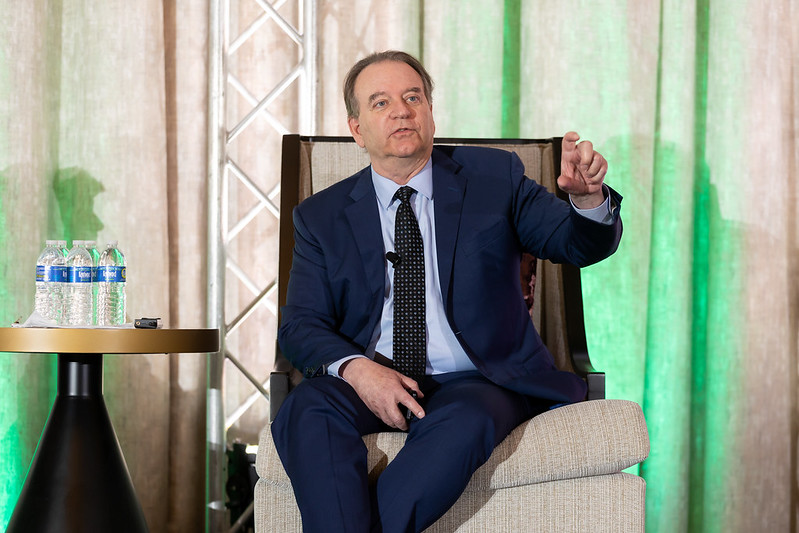 Contractors only need to conduct a discrimination analysis on legally “protected” groups; they do not need to do discrimination analyses for “reporting groups” required on federal agency forms, such as the EEO-1 Survey. Only the Congress may declare by statute who is a legally “Protected Group.”
Contractors only need to conduct a discrimination analysis on legally “protected” groups; they do not need to do discrimination analyses for “reporting groups” required on federal agency forms, such as the EEO-1 Survey. Only the Congress may declare by statute who is a legally “Protected Group.”
Reporting groups include the “Two or More Races” category and the upcoming new Middle Eastern or North African (“MENA”) reporting category.
John said that he sees this confusion “in almost every AAP.”
He explained that federal law ensures that all qualified applicants/employees/former employees must receive consideration for employment “without regard to” “race, color, religion, sex, sexual orientation, gender identity, or national origin.”
John shared a slide outlining the groups that the law protects (i.e., “Protected Groups”):
- Race = Black & White
- National Origin: Hispanic/Asian/Native American/Hawaiian/Native Alaskan
- No so-called “intersectional”- racial analyses (i.e., non-Hispanics; Black women, etc.)
- BTW: “Ethnicity” is not a legal definition of anything: it is street talk
Candee and John referred the audience to their presentation the previous day for a more detailed discussion on this point.
VI. Carrying Availability Analyses Out to Decimal Places
“OFCCP has always considered this an estimate [of availability],” he noted. “They realized if you were going to calculate availability carefully it would cost you tens of thousands of dollars per AAP so they came up with (in 1972) the notion of an estimate,” he added. (See 41 CFR Section 60-2.14.)
There are two reasons why contractors should not carry out their availability analyses out to decimal places, John said. First, naysayers will get into a nitpicky discussion of whether the AAP developers really know what they are doing since few things in business are two decimal places certain. Second, should a contractor have to defend an AAP in a courtroom, “juries think you mean that data taken out to two decimals is very precise. You don’t mean that at all,” he stated. “You are talking about +/- 10%, or more,” John estimated.
VII. Too Many AAP Developers Do Not Explain to Their Customers What is in their AAPs and What They Tell Recruiters/Lawyers
“You need to know what’s in your affirmative-action plan. You need to know your data,” Candee said. An AAP is “a strategic plan for the year in your company. It’s your strategy,” she noted.
“There’s a lot of data that’s helpful for HR in there too,” John pointed out.
“I had two clients in the last two years that tell me that they got their AAPs delivered by email, saying here’s a link to where you can find it in our online library,” John reported. “There’s no interaction, no discussion with them. I know OutSolve does it differently and happily goes through it with their clientele. That’s what you want to see so you can get that knowledge and be able to defend your AAP to OFCCP (if need be) and explain it to your superiors.”
In an audit, “you need to build credibility with the OFCCP because if you don’t have that credibility, it’s only downhill from there. If you know what’s in your data and you can answer their questions, they start thinking oh, she knows what she’s talking about. And that is so important in any audit,” Candee advised.
Also, too many federal contractors run up the cost of the development of their AAPs and compensation analyses because they pay their vendor to do the company’s data clean-up at hourly rates 10x-20x the cost of HR personnel, John said.
“Don’t ever say to the OFCCP that you’ve got to scrub your data,” Candee cautioned. “Don’t ever use that term ‘scrub your data’ because they think that you’re changing your data. You’re just cleaning it up and getting it ready so it’s legible for them blah, blah, blah. But don’t ever say ‘scrubbing your data.’”
“If you are going to clean up your data … make sure you are transparent and authentic about what the date of that cleanup was so you don’t get accused of trying to intentionally mislead the OFCCP in violation of federal criminal and civil law,” John added.
VIII. Too Many Federal Contractors Fail to Deliver the AAPs to their In-House Target Audiences
John explained that the two corporate target audiences are:
- Recruiters (need the availability data to know if they are throwing the net widely and deeply enough relative to calculated availability in your AAP for Minorities and Women); and
- The contractor’s lawyers (who need the Disparity Analyses to know whether the company is potentially liable for unlawful systemic discrimination in hiring or in compensation and perhaps in the future as to “promotions” given that OFCCP is (again) expressing interest in them.
“Don’t ever forget your leadership” such as the facility manager and upper management, Candee added, again emphasizing that an AAP is a strategic plan. Contractors have authorization under the applicable regulations to do this, John noted.
IX. Too Many Contractors Fail to Ask “Why” They Have to Set a Goal for the Recruitment of Minorities and Women
There are only five reasons to set a placement goal, John said, adding that until you know the driver(s) of your goal setting need, you do not know what to fix. “If you don’t diagnose why you have to set a placement goal, it’s like a doctor trying to prescribe medicine without knowing what’s wrong with you,” he analogized.
The five placement goal drivers for AAPs for Minorities/ Women are:
- Inadequate applicant flow – AAP says 20% available, but recruiters have only 10% knocking at the front door.
- Sufficient applicant flow, but not sufficiently high caliber applicant flow to win the one-on-one competition for the job(s) available. The fix is to “tell your recruiters to fish higher in the food stream, get better-qualified candidates, and win those one-on-one competitions,” John said.
- Historical Baggage Problem – For example, you have hired above availability for the Job Group in question for the last 20 years but are still setting a Placement Goal. You hired at x% 10 years ago but the availability for women in that job has since doubled and your Utilization analyses are NOT “time weighted” as they compare your historical hires (your incumbent employees) against the CURRENT availability. The fix is to “tell your managers don’t do anything different,” John said. “You’re doing great. You’re hiring and eventually, with enough openings, you’ll be where we want to be relative to the current availability.”
- Losing Minorites and Women out the back door faster than you are hiring them in the front door. The fix is to do exit interviews, John stated. Find out if the reasons for employee exits are troublesome, such as an uncomfortable environment for someone in a protected group. “This is where you have to look inward at your company and [consider] what’s the culture?” and what are you doing to create an inclusive atmosphere. Candee said.
- Unlawful discrimination. “This is where you’ll be buddying up with the lawyers,” Candee stated. John pointed out that, in fiscal year 2023, the EEOC took home a record > $400M in discrimination backpay monies from private companies.“You don’t have to wait for OFCCP to put a bayonet in your back” or for a plaintiff’s lawyer to send you a demand letter, John said. OFCCP regulations provide that you have an affirmative duty as a federal contractor “to go out and search like a scout if there is discrimination occurring and, if so, fix it,” he noted.
X. Too Many Contractors Confuse “Placement Goals” in their AAPs for Minorities and Women with “Hiring” Quotas
 Under the three legal authorities that OFCCP enforces there are (1) “Placement Goals” (Executive Order 11246), (2) “Utilization Goals” (Section 503 of the Rehabilitation Act), and (3) “Benchmarks for Hiring” (Vietnam Era Veterans’ Readjustment Assistance Act).
Under the three legal authorities that OFCCP enforces there are (1) “Placement Goals” (Executive Order 11246), (2) “Utilization Goals” (Section 503 of the Rehabilitation Act), and (3) “Benchmarks for Hiring” (Vietnam Era Veterans’ Readjustment Assistance Act).
The allowances [under each of these three legal authorities] are different, John explained. “You can discriminate in favor of individuals with a disability,” he said. “With protected veterans, you can have a veterans’ preference, most people believe. There’s a small concern . . . about whether this would be unlawfully discriminatory to women because the military for so long forbade women from combat, but we are now several years beyond that and female headcounts are now rapidly growing.”
In any event, they are all “recruitment goals”: the percentage of Minorities and Women, Individuals with Disabilities, and Protected Veterans you are asking your recruiters to drag, push, pull, or carry to the front door of your company so you have a chance to hire them in a non-discriminatory fashion, John stated.
That is “pretty important [to OFCCP] and is why you see every administration, including, the Biden Administration at OFCCP, emphasizing outreach and recruitment. If you don’t get minorities and women to the front door, then you can’t hire them,” John said.
If you use your Placement Goals as “Hiring” targets or quotas you must obtain, you could be found guilty of unlawful direct evidence discrimination. OFCCP would be the first to say that its Placement Goals for Minorities and Women are not quotas, nor race nor gender preferential, John said, noting OFCCP’s regulations at 41 CFR Section 60-2.16. You do not want to get this confused, particularly in light of the current heated political environment, John emphasized.
Turning goals into illegal quotas is “not the right way to fix the problem” of lacking diversity, Candee cautioned. “We see a lot of people doing that, and they basically are turning those [goals] into quotas, and legally, that’s going to get you in trouble.”
Recruit Rooster Showcased “Striking the Right Chord in Recruitment”
♪♫♪ – It is not often that a conference presentation begins with a rockin’ guitar solo, but that is exactly what the audience enjoyed as the introduction to a presentation by two recruiting professionals at Recruit Rooster. The guitarist, Sales Associate Elliott Obermaier, and Senior Director of Product Development Tyler Poling used performing music as an analogy to talent acquisition. They explored how talent acquisition technology adapts to various recruitment scenarios, and how, like music, it relies on personalized connection and developing a strong understanding of your audience. To that end, they discussed how employers can use Recruit Rooster’s Talent Engage software to collect job seeker data and deliver a personalized experience to create a genuine connection.
Playing at Someone versus Connecting with Someone
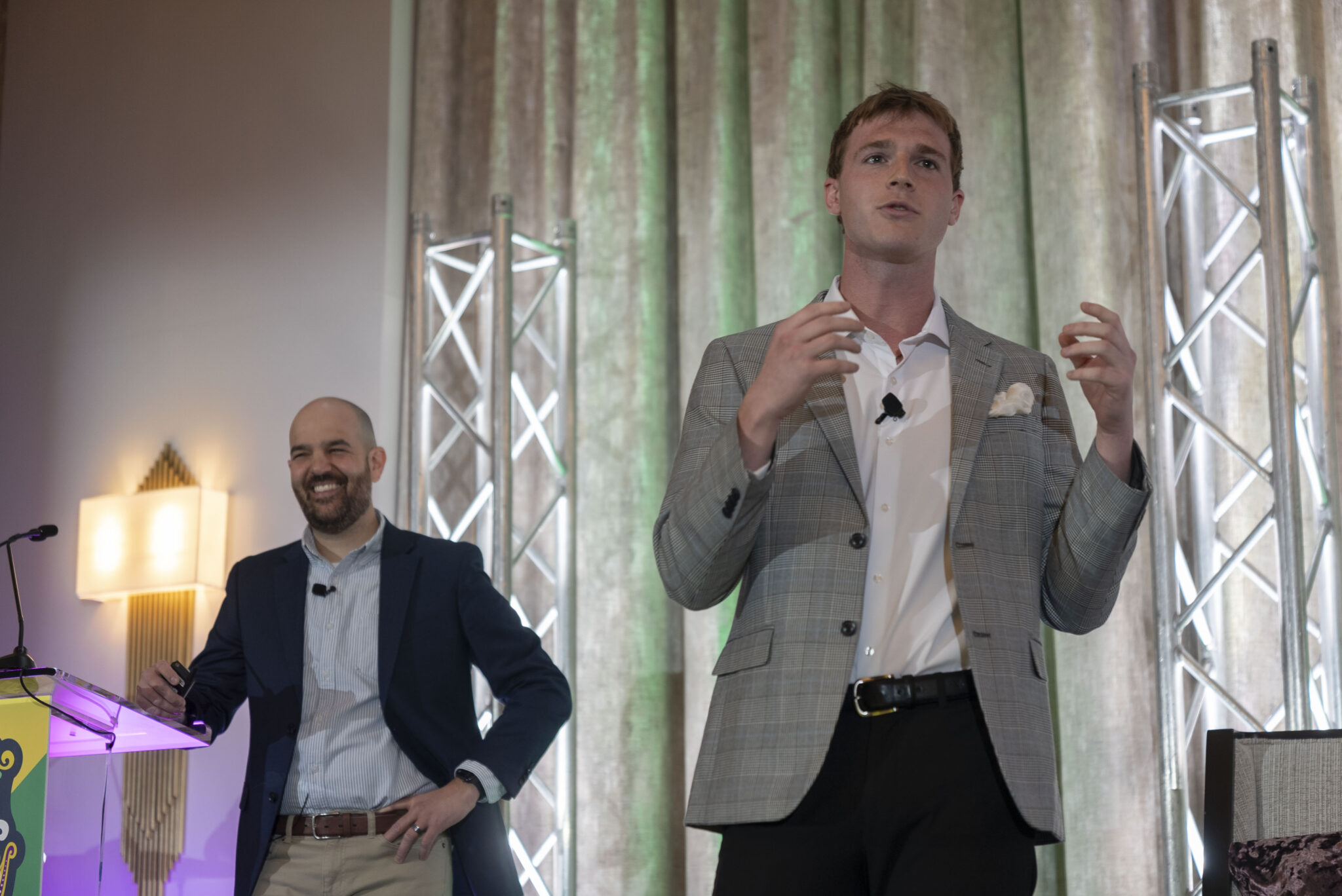 Elliott compared how his experiences as a professional musician mirrored connecting with job seekers, noting that both require a nuanced and personalized approach. He discussed the stark difference between playing music at somebody versus connecting with an engaged audience, drawing analogies to the challenges of recruitment, such as playing hard rock at a jazz club or dealing with the dissonance of a loud cover band in a restaurant.
Elliott compared how his experiences as a professional musician mirrored connecting with job seekers, noting that both require a nuanced and personalized approach. He discussed the stark difference between playing music at somebody versus connecting with an engaged audience, drawing analogies to the challenges of recruitment, such as playing hard rock at a jazz club or dealing with the dissonance of a loud cover band in a restaurant.
“One of the best parts of music and my favorite experiences in the music world was connecting with people. It was engagement I had when at a concert playing to a crowd and everyone’s very connected and comfortable, locked in and there’s the symmetry that goes between the performer and the audience,”
“Any good musician will tell you if they want to have a solid experience with solid connection with the audience, they have to recognize that their audience is different on a night-to-night basis,” he continued.
Personalized Recruiting
“Similarly to music, you have to recognize that each job seeker, each interview, each conversation is incredibly diverse and incredibly different. While your jobs have to remain the same, what you can do is tailor how that candidate sees themselves within your company,” Elliott advised.
“I’m sure everyone here has gotten some kind of recruiting thing through LinkedIn where it’s very generic. It doesn’t really cover who you are,” Tyler said. In contrast, “[w]hat we’re building from a product standpoint are unique ways to tailor these approaches to different people” by collecting data that is very specific to each individual.
“By next year, 2025, 25 percent of the global workforce is going to be made up of people from Gen Z,” Elliott pointed out, adding that Gen Z is expecting media to be incredibly personalized to them. Moreover, younger workers especially are not attached to a desk. “Therefore, anything that I can receive on my phone via text or email is going to be a lot more effective” in reaching these job seekers, he said.
At Recruit Rooster, they focus on the importance of personalized messaging, Elliott continued. “That initial outreach is where your talent acquisition professionals or recruiters are actually going to have that impact. If they’re not really connecting, not making an effort, if it’s a generic email, generic LinkedIn message, [then] the younger the generation the less likely to respond because we’ve grown up with spam,” he explained. For example, Spotify became a leading music streaming app by using data analytics to compile playlists that are specifically tailored to listeners.
Specifically, Recruit Rooster’s Talent Engage & Recruitment Marketing provide:
- Personalized messaging;
- Drip Campaigns and tailored outreach;
- Filtered and segmented data organization;
- Robust candidate profiles;
- Custom forms/data collection;
- Automated workflows; and
- Brand-focused landing pages.
Importance of Flexibility
“It is exceptionally important that everybody in talent acquisition understand the importance of flexibility,” Elliott stated. “Early on in the music world, I realized if I wanted to have any sustainable career I had to be adaptable. If I was playing a session with [a blues musician] and they wanted me to focus on that, I could do that one night, but if somebody offered me a higher paycheck to go be a session musician as a jazz player the next day it was pretty important I keep my jazz chops up as well,” he continued.
Similarly, “[o]ne of the most important elements in talent acquisition is how are you always adapting to the technology, the environment, and the situations that you’re understanding and recognizing,” Elliott noted.
Tyler discussed how building different landing pages to attract different audiences can increase the leads and how video testimonials from current employees – made by using Recruit Rooster’s Talent Attract Video platform – can also be utilized to this end.
“Using different pathways and testing things like that helps to create that connection,” Tyler said, adding that companies see a 55 percent increase in leads when they grow their landing pages from 10 to 15.
In response to an audience question, Tyler provided an example of how Recruit Rooster tools can provide flexibility. “If you’re [targeting a] driver for instance. They’re in a vehicle often. What’s going to be a good way to connect with them? Especially a delivery driver a lot of times they are sitting waiting. SMS is probably gonna be a really good way to connect with them because they can see it quickly, and understand it, and have follow-through. Or if they’re sitting but not driving, a video might be a way to approach them.”
It is all about “[h]ow do you make that individual who is looking for a new career feel like the focus is on them and the attention is there. And that their process going forward is going to be really unique and special in the role that they take in your organization,” Tyler concluded.
Abt Associates Discussed its Journey to Achieve a Successful Professional Services Internship Program
“We wanted to make sure that we really use the apprenticeship as a catalyst of change in representation,” Brian Keilson, a senior Manager of Talent Acquisition, and James Hairston, a Talent Acquisition Manager, at Abt Global repeatedly emphasized.
Brian and James described their journey into professional-level apprenticeship recruitment starting from a standing of twelve paid Interns in 2015 to 37 in the summer of 2023. They reported changing the representation of Interns from 11 White and all female to now about half of last year’s group self-identifying as minority.
A key to that change was to have Abt’s Talent Acquisition (“TA”) Group take over the outreach and pre-screening of candidates for the Intern positions. As a global company, Abt (named after its founder D. Clark Abt, a prominent MIT Professor) historically recruited from academia to be an engine for social impact through the development of new technologies and rigorous technical solutions to programs in developing countries. Abt attempts to improve lives around the globe through good health, a thriving natural environment, economic stability, effective governance, and social equity. As a socially forward company, Abt TA decided it had to break the company’s comfortable recruitment cycle of hiring colleagues from the academy from which their hiring managers had graduated or at which they had taught.
Here is how Abt TA changed it up:
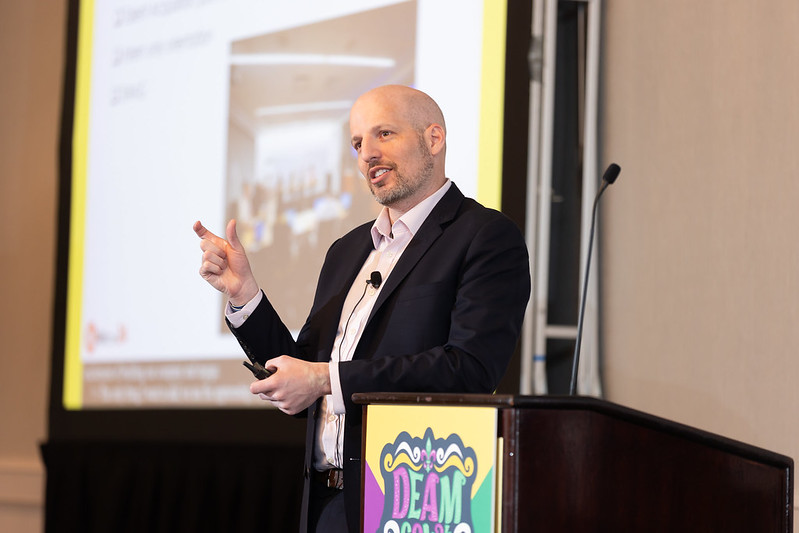 1) TA Took Outreach, Recruitment, and Pre-Screening Away from the Hiring Managers
1) TA Took Outreach, Recruitment, and Pre-Screening Away from the Hiring Managers
Brian and James described the importance of having executive leadership involved in the transformation “[b]ecause when you tell your executives, we’re going to take all the control from you in hiring, and in the process we are going to bring in our [TA] team, that can cause a little bit of shock to the system,” Brian said. Abt TA now starts each year’s November recruitment cycle of college students to join what the company calls it “Abtinternship” by convening a “Kick-off meeting” with Abt managers. “We ask them what they’re looking for in their project team and then the Talent Acquisition team goes for that,” explained Brian.
Abt TA also does not expose hiring managers to the candidates, TA sources, and pre-screens until the hiring manager goes to interview a candidate. “We don’t let the hiring managers look at resumes,” Brian said emphatically. Abt TA has concluded that preventing hiring managers from participating in the outreach and pre-screening activities has helped beat back preconceived notions about the candidate based on the hiring manager’s biases about which college or university the candidate was attending.
2) Abt TA Spends the Effort Needed Up Front to Ensure they are Recruiting at Colleges and Universities with Diverse Pools of Students Taking Courses Useful to Abt’s Mission
“We use quantitative and qualitative data as we target schools,” Brain reported.
Quantitative: “We will look at actual demographics that schools produce to really make sure that we’re getting the right representation from those schools and targeting the schools with that representation,” Brian said. “We not only look at the representation at the universities, but make sure the programs that we typically recruit from have that representation,” he underscored. So, while the university or college as a whole may be diverse, the more important question Abt TA discovered is whether the subspecialty education program (i.e., economics or biology, etc.) of interest to Abt at the college or university is also populated with diverse students.
Qualitative: Because schools do not always give Abt representation data by educational program, Abt resorts to “qualitative” processes, including talking to faculty members and students to understand if particular school programs of interest to Abt enjoy a diverse population of students.
3) Abt TA Found It Important to Build a Relationship with Abt’s Hiring Managers to Sustain Their Trust
Echoing comments DE Board Member and Recruiter Mike Bazinet made to kick off the DEAMcon24 conference the previous morning as to the necessity to collaborate with company compliance managers, James emphasized the necessity for TA to also collaborate with hiring managers and to candidly discuss with them what has worked and what had not. “Probably the most important thing,” James said, was “showing empathy within those meetings” with the hiring managers if you wanted to have a good Kick-Off Meeting.
In recent years, Abt TA has learned, James reported, that it is especially useful to provide the hiring managers with a “document that goes over the basic biases that a hiring team could have.” Another learning point was to “have a Plan B” when the hiring managers begin the process of interviewing candidates in case the hiring manager is suddenly called away at the last minute before the interview. To avoid disruption and potential loss of the candidate, James strongly suggested that TA work with its hiring managers to have a backup interviewer available to step in if the intended interviewer becomes unavailable for the interview.
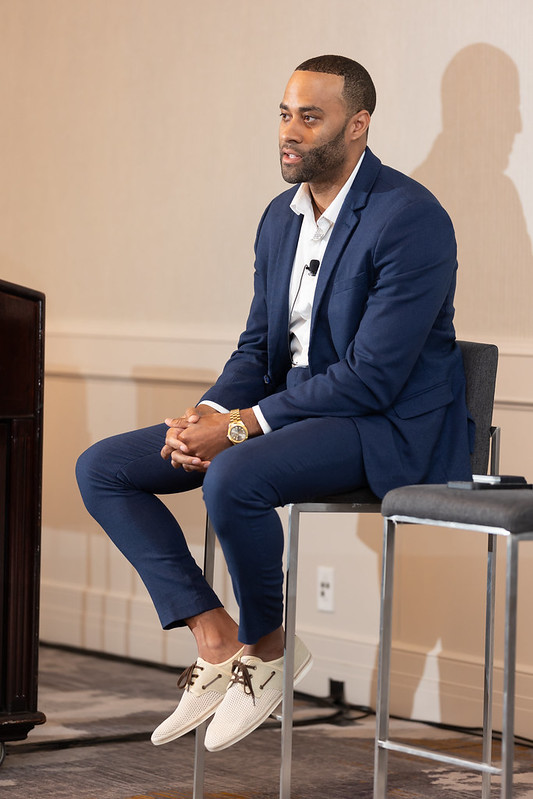 4) James Warned Against “Group Debriefs” to Select Candidates for Employment to Avoid a Herd Mentality
4) James Warned Against “Group Debriefs” to Select Candidates for Employment to Avoid a Herd Mentality
“Group bias is very real,” James reported. He offered the example of a strong leader taking an outlier position against or for a candidate causing others in the debrief to follow the leader because of the felt pressure to agree with the boss. Rather, James reported that Abt TA looked at each feedback from those who interviewed a candidate. Then, Abt TA proceeded in the way of a mediator to approach the interviewer with the outlying opinion in an effort to obtain consensus by having “a conversation” on why that interviewer had taken the position s/he had adopted.
5) Maintaining Ongoing Engagement with the Intern Is Important to Land the Recruit
Abt does not practice “catch and release.” Rather, James advocated an ongoing course of contact between TA and the Intern with weekly and bi-weekly check-ins. Brian also recommended the use of a “buddy system” (pairing recruits together, especially if they work remotely) so they have a colleague to whom to speak privately and candidly about their respective challenges and progress with work assignments. Both Brian and James emphasized the need and utility to obtain during the Kick-Off Meeting the hiring managers’ specific commitments to both attend meetings with their Interns and to allow their Interns to spend work time attending trainings and other company social events.
James pointed out, too, that a “lesson learned” was that it was “really important” that the Interns “feel seen when they come to Abt.” This is not something left to chance, but rather something Abt TA works with the managers of the Interns to make sure occurs through group or project team presentations and attendance at meetings with senior Abt managers.
Addressing the special needs of remote Interns, which Abt allows, James humorously suggested the use of “gifts.” Also, Abt TA sets up a Microsoft Teams channel to get the Interns together as a group. James also suggested the use of Slack and other communication systems to allow for synchronous communication. He encourages the always time challenged Abt managers to simply e-mail or text in lieu of a longer or more involved live communication if they do not have the time to jump on a Teams or telephone call. Abt TA also collaborates with the company’s Interns to get them comfortable to “turn on their cameras” while on Teams calls to engage them. But James’ grand conclusion about remote working interns was: “Having fun with remote work is the biggest thing we try to set up.”
6) ABT TA Holds its Hiring Managers Accountable to Follow Through on their Commitments to the Intern Program
Waking the talk: Abt TA also manages the Intern process by making sure that it holds hiring managers “accountable” to hold up to their commitments made at the Kick-Off Meeting to the Intern program. TA makes sure the manager is supporting his/her Intern during their summer work. Brian explained that TA also uses the every-November Kick-Off Meeting starting Abt’s recruitment season to extract commitments from the hiring managers of their time and budget to support the Intern that manager will be sponsoring.
Tough love: Abt TA also emphasizes that the penalty to the hiring manager, if s/he reneges on his/her commitment to a hired Intern, is that TA will no longer supply Interns to that manager to help build the staffing of his/her group or project.
Unlocking the Power of Apprenticeships & HBCUs to Build a Diverse Talent Pipeline
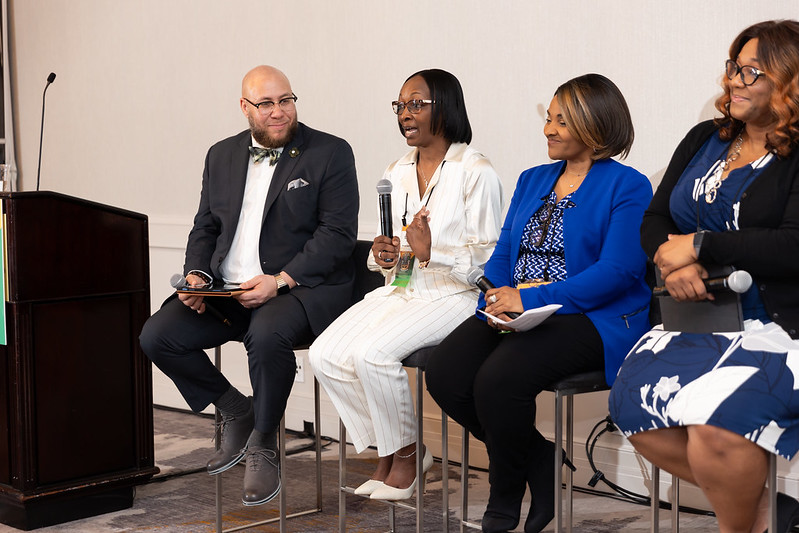 DEAMcon24 attendees had the privilege to learn about the benefits and real-life practical considerations in the use of registered apprenticeships with Historically Black Colleges and Universities (“HBCUs”) and Historically Black Community Colleges (“HBCCs”). Providing insight from the viewpoints of employers, HBCUs and HBCCs, and the state agencies involved in apprenticeship programs, speakers provided first-hand knowledge of using apprenticeship programs to obtain a diverse workforce with the ready experience to fill job openings.
DEAMcon24 attendees had the privilege to learn about the benefits and real-life practical considerations in the use of registered apprenticeships with Historically Black Colleges and Universities (“HBCUs”) and Historically Black Community Colleges (“HBCCs”). Providing insight from the viewpoints of employers, HBCUs and HBCCs, and the state agencies involved in apprenticeship programs, speakers provided first-hand knowledge of using apprenticeship programs to obtain a diverse workforce with the ready experience to fill job openings.
Moderated by Joshua Johnson, Director of Solutions Design & Delivery at Jobs for the Future (“JFF”), the esteemed panel represented the three legs necessary to the creation and growth of apprenticeship programs in communities facing systemic barriers. These presenters were: Damita Hill, Executive Director of Community and Workforce Development at Trenholm State Community College; Stefanie Willis-Turner, the Director of Nursing School Partnership and Programs at Mobile Infirmary Medical Center; and Tawanna Robinson, Region 2 & 4 Project Manager at the Alabama Office of Apprenticeship.
What is a Registered Apprenticeship?
The discussion focused on how to create and use registered apprenticeship programs. These are apprenticeship programs that entail opportunities involving work routinely learned on the job with a minimum of 144 hours of schooling attached to it and which takes a minimum of one year to complete. This included practical knowledge and substantive insight as to the part each speaker’s domain plays to create a successful program. The seminar was especially relevant to JFF’s objective of placing 75 million people facing systemic barriers into quality jobs (positions that provide living wage and benefits, stability, and economic advancement) over the next 10 years. This included highlighting the fact that apprenticeship programs now encompass various occupational fields, including a growth of such programs in accounting, IT, health care, cybersecurity, and STEM industries.
What HBCCs Can Offer
Damita began her discussion reminding attendees of the existence of HBCCs and the importance of programs in such schools geared toward training students in job skills and work experiences. Damita identified both credited courses leading to obtaining an associate degree and noncredit pursuits directed toward short-term certificate training as classes HBCCs offer to students to help them learn work skills necessary for various occupational fields.
This requires not only faculty and staff at HBCCs offering mentorship opportunities, but also conducting outreach directly to students to identify their talents when matching them with employment opportunities in the area. Damita noted that at Trenholm, one aspect that has helped ensure that students are attractive to employers has been communicating with employers directly as to the skills and traits they expect from employees. Trenholm also customizes training and curriculum to match those needs. For example, this could include scheduling the program at times that current employees with the requisite knowledge are on-site to train the apprentices and scheduling classes around the work hours accordingly. Damita noted that as important as outreach is for HBCCs, employer communication and engagement to assist the educational community to achieve a successful program is just as valuable.
What Employers Should Know When Creating an Apprenticeship Program
Stefanie provided valuable, practical knowledge of employer creation and use of apprenticeship programs based on her experience creating an apprenticeship program at Mobile Infirmary Medical Center. Stefanie assuaged fears of starting from scratch by noting her own education and learning experience in creating an apprenticeship program through research, phone calls, and even some mistakes along the way.
One important aspect of obtaining value from an apprenticeship program for employers is to ensure commitment to the students. Stefanie noted her own efforts in being the apprentices’ voice and treating them like employees. Such mentorship ensures apprentices understand the value of the work they perform and the obligations an employer expects from them so that employers obtain ready employees following completion of the program. Furthermore, by bringing on students and teaching them itself, Mobile Infirmary eliminated the burden of having to hire adjunct faculty since the actual nurses are doing the on-the-job teaching. This creates a substantial return on investment for the employer. For example, Stefanie noted Mobile Infirmary’s relationship with a college in Mobile, Alabama resulted in each of the graduates of the program passing their NCLEX certification test (necessary to carry a nursing license in Alabama) on their first try.
How State Agencies Can Help
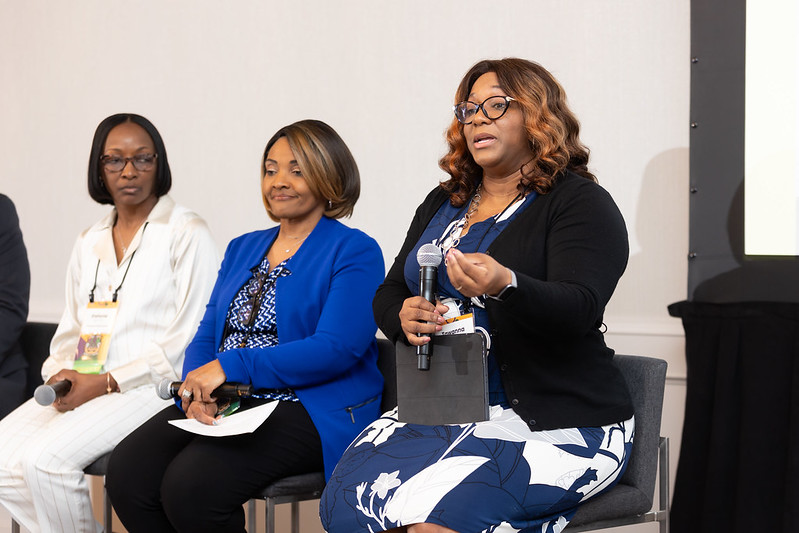 Tawanna emphasized the role governmental agencies can play to bring employers and HBCUs and HBCCs together. This includes educating the public that apprenticeships are for everyone, informing employers as to what apprenticeships are, and working with educational institutes as to what employers are looking for regarding the educational component and training. Tawanna also noted her agency’s ability to identify funding or grants available that can assist in reimbursing employers the cost of tuition for the apprentices in their program.
Tawanna emphasized the role governmental agencies can play to bring employers and HBCUs and HBCCs together. This includes educating the public that apprenticeships are for everyone, informing employers as to what apprenticeships are, and working with educational institutes as to what employers are looking for regarding the educational component and training. Tawanna also noted her agency’s ability to identify funding or grants available that can assist in reimbursing employers the cost of tuition for the apprentices in their program.
Tawanna identified how the state agency can assist in the process from the first introductory conversation. State agencies can identify an employer’s needs, the job description, and the skills the employer is seeking to fill. The states can also use this information to identify an employer’s goals and where gaps may exist in the available workforce. State agencies also assist schools to develop training plans to align with employer needs.
The Most Important Aspect to a Successful Program – the “Secret Sauce”
As Tawanna noted, “Relationships matter, and so making sure that business and industry who want to have these opportunities squarely understand what an apprenticeship program consists of and to whom they need to be speaking.” Joshua echoed that sentiment by stating, “When we think about apprenticeship, you said what the secret sauce is. The secret sauce is relationships. The apprenticeship world is all about relationship[s]. What we have seen is engaged both employers and historically black community colleges and universities.”
Best Practices
The presenters summed up the seminar by noting the following “best practices” advice for attendees interested in an apprenticeship program:
- Communication. It is important for business and industry leaders to:
- have the first conversation with the state apprenticeship program to learn where the employer needs to go to make contact with participating schools and to identify resources available, and
- engage with the educational institutions to identify new programs or needs so the schools can ensure training programs are hitting the right points, and
- meet with the students while they are in the training programs and engage them.
- Stay factual and up to date with job descriptions to avoid unintentional barriers for students interested in an apprenticeship and to ensure apprentices are aware of what they can do in the position as an apprentice instead of a full-fledged employee.
- Encourage decision-makers to participate in apprenticeship programs by highlighting the substantial return on investment of such programs. Employers can avoid the costs of training after hiring a new employee when the training occurs as part of the apprenticeship program.
- Treat apprentices as employees to ensure a return on the investment by educating the apprentices to the responsibilities the employer expects and respecting the work they perform.
Practical Considerations of Artificial Intelligence: What No One Tells You
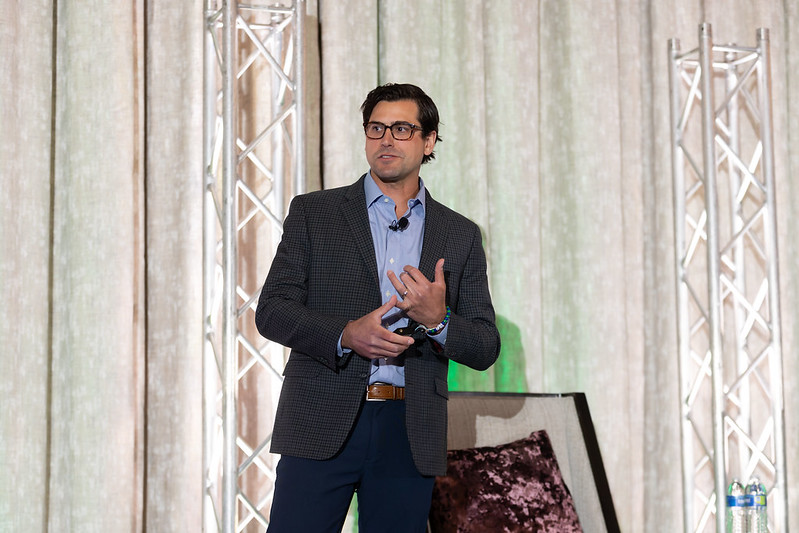 While Artificial Intelligence (“AI”) holds tremendous opportunity for employers in their HR decision-making, it poses serious threats to DEI and legal risks. Brian Marentette, Director of the People Insights Division at Biddle Consulting Group, discussed the application of AI and how it implicates DEI and legal risk exposure.
While Artificial Intelligence (“AI”) holds tremendous opportunity for employers in their HR decision-making, it poses serious threats to DEI and legal risks. Brian Marentette, Director of the People Insights Division at Biddle Consulting Group, discussed the application of AI and how it implicates DEI and legal risk exposure.
“[AI is] a pretty popular topic lately, and it’s creeping its way quickly into HR and into recruitment specifically,” Brian observed.
“When it comes to HR, really what we’re seeing is that its largest application is in resume screening,” he reported. He noted that there are “natural language processing tools that can digest resumes and look for keywords that you have fed to that algorithm to identify potentially qualified candidates.”
Furthermore, employers are using AI to administer interviews and conduct employee onboarding. “AI has also been used in assessing candidates during interviews,” he reported.
How AI works
AI works by developing algorithms to train “Neural Networks” to seek pattern(s) in data. In the hiring context, employers use a very simple version of AI to train Neural Networks to connect data to outcomes. Sources of data include resumes, video interviews, tests, and game playing. Outcomes include a successful resume candidate and a high performer in a given job.
“A lot of times we don’t really know what’s going on with the algorithm. That’s referred to as this black box concept,” Brian said. “It’s becoming more and more taboo to have a black box model, especially in HR. It needs to be explainable,” he continued.
To train itself, AI is “heavily reliant upon a lot of data, and that’s a big, big question or point of contention right now. If you are a small employer, you don’t have a lot of data. What is your AI algorithm being trained on? Somebody else’s data. But is that data going to actually map into your organization,” Brian asked?
“There are also problems in terms of what patterns the AI algorithm is using or is finding,” he said. All patterns are not important and meaningful. One problem is “spurious correlations.” He shared the following graphic to illustrate:
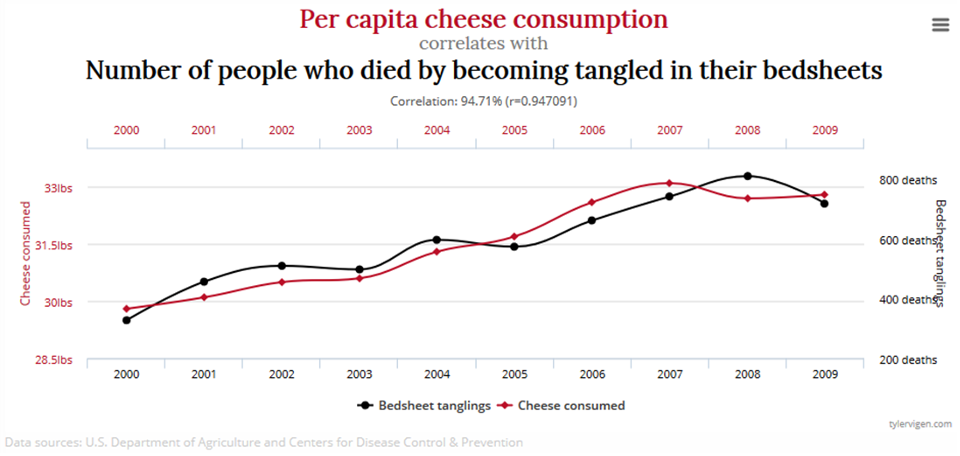
One-time events, such as the Great Resignation and COVID-19 pandemic, “can skew the data that you might be looking at [rendering] it as [unreliable] when you go to use it for actually making decisions,” Brian said.
Where Can AI Cause You Problems in HR?
Brian identified two veins of concern when using AI in HR practices. First, consider whether an AI tool is assisting you with a task, such as job ads and answering questions during onboarding. If so, does this task ultimately lead to a decision you make about an applicant/employee? Does it (a) write job descriptions for you, (b) write performance reviews for you, and (c) suggest “good candidates” in social networks? “You don’t want to go before a judge and explain how [AI] wrote your job performance review,” he cautioned.
Second, consider whether an AI tool is making decisions about applicants/employees for you, such as scoring resumes and administering or scoring interviews. This area is where the greatest risk occurs, he said, noting that this is where the EEOC and OFCCP are most concerned.
Proponents of AI in HR value the potential for increased efficiency and objectivity in personnel decisions. Busy recruiters are interested in tools that can make their lives easier, Brain said. AI tool developers assert that because machines are “learning” but not thinking like humans, they cannot apply their own biases. However, the implicit bias of the developer can still be baked into the creation of the algorithms, software, and other tools.
“No matter how hard some of these companies try, they cannot get rid of a bias in their algorithms and it’s because it’s in the data. Even if you’re using your own data to try to train these algorithms,” their bias will still occur, Brain pointed out. Accordingly, it is important to consider what data were used for algorithm training.
“Bias in algorithms is really going to be where all the damage is done in the next decade or so,” he predicted.
AI in Practice
Brain shared three basic concepts with machine learning related to HR:
- Pattern Recognition (speech, image, language) > Interviews
- Natural Language Processing (NLP) > Resume Screening – e.g., Translation (Google Translate)
- Large Language Models (LLM) > Job Descriptions – e.g., ChatGPT, GPT 3 & 4, e.g., LaMDA, PaLM
He said that what no one tells you about AI in terms of diversity and equality is that:
- AI is “trained” to emulate (biased) human decision-making;
- AI is not creative; it emulates and maintains the status quo. “It is not like on its own just out there making itself better every day,” he observed;
- AI emulates human decision-making and bias in data. If bias is not identified and removed, bias will be perpetuated and propagated – at SCALE;
- If not careful, AI may allow large amounts of employment actions to occur before you realize the “decisions” were biased;
- Constantly changing predictive models as AI receives new data. “There’s real potential if it’s not monitored, if there’s not a human involved, in the process for it to go sideways,” he said;
- Overfitted Models: AI/Neural Networks are overly trained to existing data, which means that they assume large data size approximates population parameters. Also, this can lead to unstable models based on one-time events;
- Model Drift: AI/Neural Networks are constantly trained on new data;
- Fail today…Pass next month – AI’s determinations as to who is qualified may shift from one month to the next. “Did the qualifications really change the last two months? Probably not,” he pointed out;
- Is a shifting goal-post defensible?; and
- Validation per Uniform Guidelines on Employee Selection Procedures (“UGESP”) standards. “[That] is the standard the courts will use to evaluate employment procedures,” including AI, he said.
Compliance Focus
Brian reviewed the types of “bias” relevant in the employment law compliance context:
- Disparate Treatment – Decisions that treat individuals less favorably than similarly situated individuals based on a protected characteristic. “That’s the iTutor case,” he noted, adding that “It really wasn’t an AI case but it was touted as one by the EEOC.” (see our story here for details on that case);
- Disparate (Adverse) Impact – Facially neutral policy/practice/test that results in a substantially different rate of selection or promotion that disadvantages members of a protected group. “That’s where we find those AI cases popping up,” he said, adding that “Most developers will be paying attention to this, but some don’t;” and
- Test bias (unfairness) – Differential validity for different protected groups.
“There is no standard out there for artificial intelligence adverse impact versus regular adverse impact. It’s all the same right now,” Brian pointed out.
AI vendors tend to use the 4/5ths or 80% rule of thumb, rather than more exact statistical tests (such as Fisher’s Exact and Chi-square), he said. However, the more exact statistical tests must be applied to ensure legal compliance. “These AI vendors … don’t look at it the same way you need to as a [federal] contractor or … anybody subject to Title VII,” he cautioned.
“The bottom line, if you are looking for adverse impact resulting from the use of an AI tool, is that you have to view it as a steps analysis,” Brian explained, meaning you have to assess for adverse impact at each stage of the hiring process.
Another important consideration is the sample size. “If you’re using AI, it’s probably because you are a large employer with an unwieldy number of applicants … [and] you’re looking for something to gain some efficiency. That’s great. That is where AI would make the most sense,” Brian observed.
However, smaller employers will have smaller sample sizes which changes the equation. “The problem with that is with statistical testing small differences are highly meaningful when it’s a difference that’s observed in a group of 50,000 people. The agencies out there do not care how significant or how small [those differences are]. Even a five percent difference in selection rate can pop up at a 15 standard deviation level when it’s in a group of 50 or 100,000 applicants,” he cautioned.
He shared a chart showing what is the sample size that’s required to find a statistically significant disparity based on the passing rate difference.
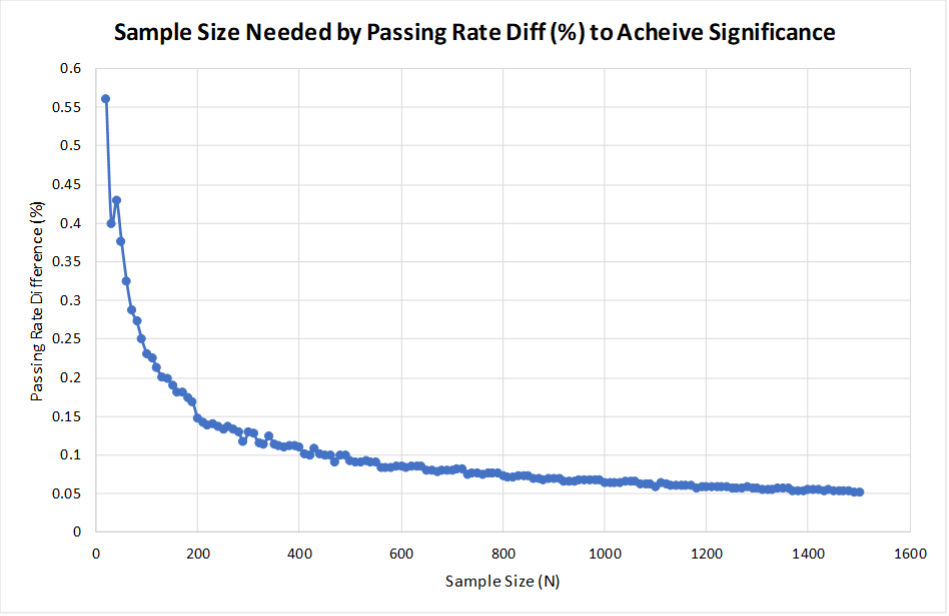
“If you have a small employer and you have two hundred applicants, you need about a 15 percent difference in the selection rate so that’s a huge difference. That’s pretty sizable. If you have a tool producing that much difference, you should see it and not use it. It doesn’t matter what the statistical significance is,” he advised.
Validation
 If an employer finds adverse impact, it either needs to stop using that tool or validate it. “Adverse impact is really unavoidable with artificial intelligence if you’re using it on these large groups of people. It’s almost a guaranteed outcome. You either have to stop using it or you need to validate it. The validation piece is really where the rubber hits the road. That’s the hardest part for contractors to do and for these vendors,” Brian said.
If an employer finds adverse impact, it either needs to stop using that tool or validate it. “Adverse impact is really unavoidable with artificial intelligence if you’re using it on these large groups of people. It’s almost a guaranteed outcome. You either have to stop using it or you need to validate it. The validation piece is really where the rubber hits the road. That’s the hardest part for contractors to do and for these vendors,” Brian said.
“Specialist-related testing for validation according to the Uniform Guidelines [on Employee Selection Procedures] is not the same as validation in the artificial intelligence world,” he pointed out. For employers, UGESP Validation Requirements are still the standard, and they must not conflate validation of the algorithm “working” with validation of the tool to make employment decisions, he cautioned.
“Any preselection procedure which has an adverse impact will be considered discriminatory unless the procedure has been validated in accordance with [the UGESP],” he stated. “It’s not that you can’t validate these AI algorithms, it’s just a different beast,” he continued.
Challenges to note in validation are:
- Algorithms change frequently because they are … “intelligent.” The pros of this are that it can capitalize on new data/patterns/trends. The cons are the drift in the model/parameters (the qualified today/ not-qualified tomorrow conundrum discussed earlier);
- Do you know what to validate? What are you measuring? Brian reviewed some issues previously discussed including Natural Language Processing Resume tools – keyword content terms in resumes, the black-box that produces a “score,” and chat-bot interview scores; and
- The AI tool must be explainable and measure important knowledge, skills, and abilities.
Practical Compliance Considerations
Wrapping up, Brain summarized with the following Best Practices and advice:
- If an AI tool results in a meaningful statistical impact on one or more Protected Groups, the employer is responsible to defend the tool, not the vendor – Beware the “bias-free” sell!!
- Consider –
-
- For how many jobs are you using the tool? Is it even feasible to do validation work? (e.g., 1,000 jobs)
- Most likely relying on criterion validation (“which essentially statistically relates the score on your test with the score of job performance or turnover,” he explained – will it pan out?
- What will you correlate AI tool scores with? (performance, turnover?)
- What is the cost of doing this work?
- How often does the algorithm update?
- Will you even be given access to the data necessary to do validation?
- Access if you need to be using AI
- Understand all options and use only when (absolutely) necessary
- Monitor using UGESP Methodology
- What/How: Selection Rate differences and significance testing
- When: Depends on your velocity (see sample-size power chart featured above)
- What if there is Adverse Impact?
- Validation per UGESP standard for every AI model (iteration/step in the process), or stop using it
A Recruiter’s Role in Compliance: Validating Job Requirements & Impacts on Hiring Processes
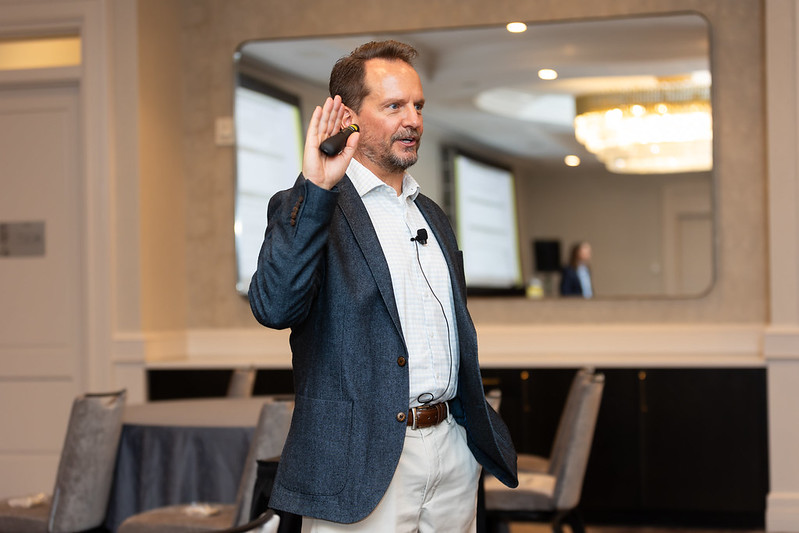 Two speakers from Colorado Springs Utilities – Sam Lawson, a Talent Acquisition and Selection Specialist, and Jonathan Liepe, Human Resources Supervisor for Talent Acquisition and Selection – regaled attendees with front-line perspectives on a recruiter’s role to ensure compliance in the hiring process. Specifically, both presenters highlighted that recruiters cannot be “order takers” in their roles, merely taking the job requirements and finding an individual that meets the qualifications. Rather, recruiters must operate as “talent advisors,” working with hiring managers to understand job descriptions and skill requirements identified in the opening and anticipating what that looks like in the workplace.
Two speakers from Colorado Springs Utilities – Sam Lawson, a Talent Acquisition and Selection Specialist, and Jonathan Liepe, Human Resources Supervisor for Talent Acquisition and Selection – regaled attendees with front-line perspectives on a recruiter’s role to ensure compliance in the hiring process. Specifically, both presenters highlighted that recruiters cannot be “order takers” in their roles, merely taking the job requirements and finding an individual that meets the qualifications. Rather, recruiters must operate as “talent advisors,” working with hiring managers to understand job descriptions and skill requirements identified in the opening and anticipating what that looks like in the workplace.
Jonathan began by reminding attendees of the regulations and laws that instruct H.R. on compliance requirements in hiring. These legal standards require employers to analyze whether the selection criteria and job requirements employers use are real or “neutral factors” that can give rise to adverse impact based on a protected category. To ensure the factors an employer uses are legitimate reasons to select or not select an applicant, recruiters should engage with hiring managers to identify the knowledge, skills, and absolutes necessary to “do the job” by knowing the tasks and responsibilities of the position. This is because recruiters often serve “in the front line in our defense and risk of mitigation for the organization.”
Thus, recruiters should conduct a job analysis and understand the basic qualifications for a position. For example, Sam cited work experience and educational requirements an employer may note as a minimum qualification. However, recruiters should ask hiring managers what would seven years of experience provide that a person with six years and nine months of experience could not? Similarly, what about a college education is necessary to perform the job? Often, college education is used as evidence of communication skills. However, this means the employer just wants an individual who is an effective communicator, which can be had with or without a college degree. One example of a type of job analysis is the use of critical incident methodology to bring subject matter experts in the room to discuss what a job requires, how the requirements affect job performance, and how that assists the hiring manager in visualizing the selection criteria. If a proper job analysis is performed, an employer can then have proper knowledge for its compensation team to market price the open positions correctly. Furthermore, a job analysis satisfies an employer’s obligation under the regulations to regularly review physical and mental requirements for positions.
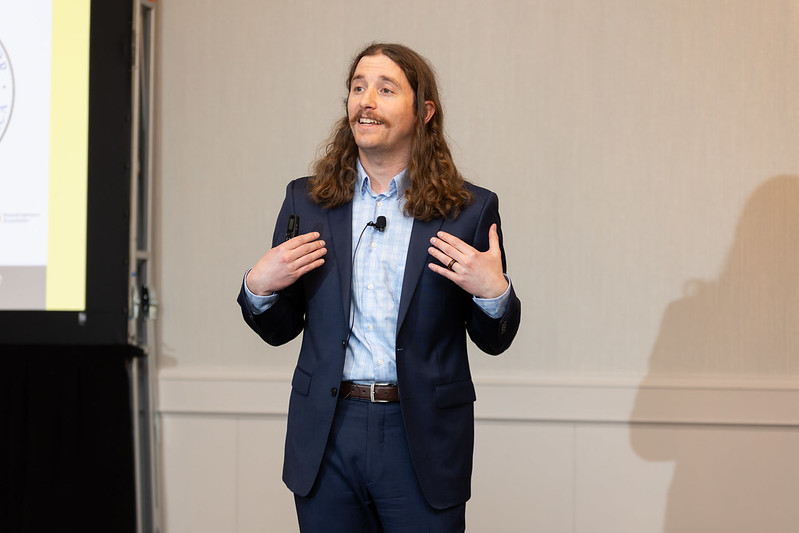 Jonathan and Sam then discussed how recruiters must ensure that any pre-employment test used in the application process to verify qualifications or job skills is valid, relevant, and consistent with business necessity. The presenters reminded attendees that any “yes, no” decision in the selection process is a pre-employment test, and that such tests must meet two criteria: (1) the test must be reliable and (2) valid. Reliability means the test is consistent, i.e., an individual who takes the test on separate occasions should score close to the same in both instances. Validity means both that the test used measures a person’s ability at the same or equivalent levels as other tests that measure such ability, and that the content effectively measures what the employer is seeking to obtain. Jonathan and Sam then discussed concerns and benefits related to specific categories of pre-employment tests, and how work knowledge and work sample tests tend to be the most beneficial in the hiring process.
Jonathan and Sam then discussed how recruiters must ensure that any pre-employment test used in the application process to verify qualifications or job skills is valid, relevant, and consistent with business necessity. The presenters reminded attendees that any “yes, no” decision in the selection process is a pre-employment test, and that such tests must meet two criteria: (1) the test must be reliable and (2) valid. Reliability means the test is consistent, i.e., an individual who takes the test on separate occasions should score close to the same in both instances. Validity means both that the test used measures a person’s ability at the same or equivalent levels as other tests that measure such ability, and that the content effectively measures what the employer is seeking to obtain. Jonathan and Sam then discussed concerns and benefits related to specific categories of pre-employment tests, and how work knowledge and work sample tests tend to be the most beneficial in the hiring process.
In summary, recruiters must learn to vet the requirements for an open position and evaluate the tools used in the hiring process to comport with the requirements sought.
Partners in Talent Acquisition: WorkSource Business Services & Statewide Support
 In Washington State, WorkSource offers a partnership of organizations dedicated to developing a workforce with the skills businesses need. Two Navy veterans and professionals at the Washington Employment Security Department – Hannah Schoepp, Statewide Local Veterans Employment Representative, and Seth Maier, Veteran and Military Families Program Operator – shared information about the workforce business solutions offered by the department, with a particular focus on applying HR strategies to military-connected employees.
In Washington State, WorkSource offers a partnership of organizations dedicated to developing a workforce with the skills businesses need. Two Navy veterans and professionals at the Washington Employment Security Department – Hannah Schoepp, Statewide Local Veterans Employment Representative, and Seth Maier, Veteran and Military Families Program Operator – shared information about the workforce business solutions offered by the department, with a particular focus on applying HR strategies to military-connected employees.
WorkSource is Washington’s version of the American Job Centers, Hannah explained. “It is a consortium and a partnership under one roof of nonprofits, state agencies, and other organizations that are all working together to provide direct employment services and to make sure that our workforce that we have in our local area skill sets meets what’s needed and required by employers in the area,” she elaborated.
Hannah detailed WorkSource’s many partnerships and services to meet the needs of both employers and workers. “We like to say we walk alongside you through the recruitment process. This includes all of the stages which are preparing for it, sourcing, screening, selecting, hiring, and even part of the onboarding process that we assist with as well,” she said.
WorkSource’s on-site services are available in different offices “strategically located throughout the state of Washington so that every [region] is covered, Hannah stated. They also work in various locations with their nonprofit partners.
The WorkSource website includes access to Washington’s largest talent database with verified job seekers and it posts job listings for employers, Hannah said, all at no cost to users. They also offer virtual job fairs and ways for employers to schedule chats with job seekers.
For veterans, the WorkSource offices have case managers who work one-on-one with veterans and transitioning service members, Hannah stated, adding that some military spouses may also qualify for this service. Although these case managers are called Disabled Veteran Outreach Programs Specialists (“DVOPS”), they work with non-disabled veterans as well, she noted. They also conduct veteran and military spouse hiring events with major sponsors such as the Seattle Seahawks and the Seattle Mariners.
The YesVets program is a statewide hiring initiative where WorkSource recognizes employers who hire and retain veterans. Hannah also noted the federal HIRE Vets Medallion Program. “We are thankful to have them both [because] the HIRE Vets Medallion Program is bigger and beyond what just Washington State can offer,” she said.
OFCCP Inquiries
Seth pointed out the OFCCP’s regulations at 41 CFR Part 60-300.44(f), which require covered federal contractors to undertake “appropriate outreach and positive recruitment activities” detailed in the regulations. Specifically, he noted Part 60-300(f)(2)(i)(A) which states that contractors may meet their obligations by enlisting the assistance and support of their “Local Veterans’ Employment Representative in the local employment service office (i.e., the One-Stop) nearest the contractor’s establishment.”
When OFCCP conducts an audit of a federal contractor in Washington State, they start by sending an inquiry letter to the Washington Employment Security Department/WorkSource, Seth said. In this letter, the OFCCP asks them about some of the following things:
- Are the job openings that the contractor is listing appropriate for our delivery system?;
- Are we getting an appropriate number of job postings being posted in our system?;
- Are they being identified as a federal contractor?;
- Is there a point of contact provided?; and
- Are the required priority for referrals for veterans being listed?
Seth explained that when he does his investigation to prepare his response to OFCCP, the first place he looks is in their WorkSource system for all the jobs that the contractor sent to that system. With that, he can provide a full two-year history. “I make sure those categories [listed above] are met,” he said. “But when I don’t find those results, the next thing I do is look into our job board for any of those scraped-in job postings coming into the system,” he added. Then he goes to the National Labor Exchange. If he still does not get any results, he turns to DirectEmployers’ VetCentral.
Editor’s Note: Seth is speaking explicitly about job postings – NOT job listings. Listing jobs is the regulatory requirement for federal Government contractors and subcontractors with a contract of $150,000 or more. Under this regulation, they must meet the requirements found at 41 CFR 60-300.5(a)2 and (a)3. If they do not, they will be cited in a compliance evaluation/audit with the OFCCP.
After that, they prepare a report to respond to OFCCP’s inquiry letter. If their findings are “unfavorable,” the Washington Employment Security Department/WorkSource will have one of their Local Veterans Employment Representatives reach out to the department’s regional office in the area of the state nearest the contractor and “[inform] them of the discovery so they can contact the employer and offer that technical assistance to help them get back in compliance.” This effort occurs immediately after they send their response to OFCCP. “We are not notifying you that you are audited,” Seth said. Rather, they tell the contractor that they “requested an inquiry on your business and we found unfavorable things we want to help your business get into compliance,” he stated. “We want to strengthen our relationship with that employer by offering these services because we’re really looking out for you,” he explained.
Bev Harp Explained the Neurobiology of Autism and Provided Many Practical Tips to Recruit and Interview Autistic Applicants for Employment
We thought we knew a lot about autism in the workplace until Bev Harp, an Educational Specialist at the Human Development Institute (“HDI”) at the University of Kentucky, began to speak. Bev was one of the most impactful speakers at the conference even though we sat down in her session expecting yet another autistic accommodation presentation. Bev, who is autistic, also made two observations (discussed in greater detail far below) that we had never previously heard any other speaker express at any conference or online seminar concerning autism. Both of her postulated theorems immediately started sparking original thoughts in our brains and got us thinking about them for days after:
- “I try to help people look at autism as a diversity issue and not just a disability;” and
- “Autism is an immutable characteristic, like color.”
1) The Biology of the Autistic Brain is Fundamentally Different Than That of a Neurotypical Individual
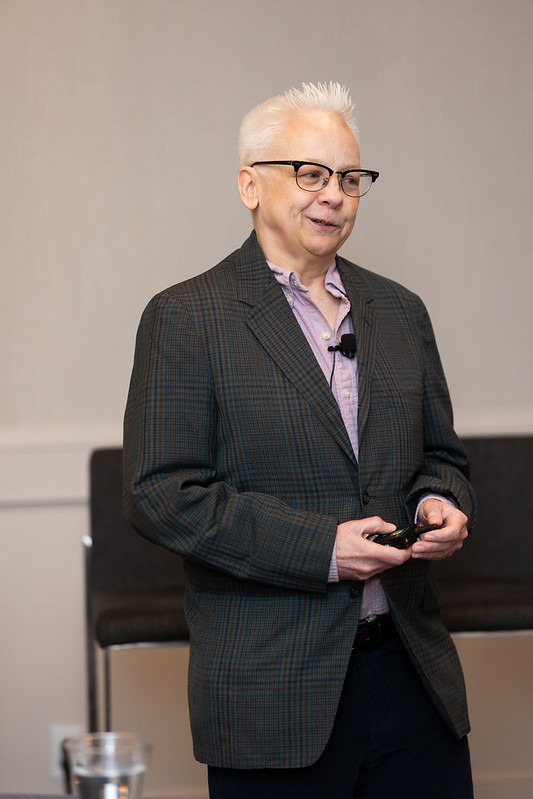 Bev was right to start with a discussion about the fundamental differences between a neuroatypical brain in a person with autism and the brain of a neurotypical person. Bev observed that we had likely not heard much about the autistic brain and how it is different. “This is the source of differences,” Bev asserted. “I think that once people understand this—that it is hardwired into us—they will then understand that autism is not a collection of behaviors that need to be treated, but rather that autism is the outward expression that you see because of the brain difference.”
Bev was right to start with a discussion about the fundamental differences between a neuroatypical brain in a person with autism and the brain of a neurotypical person. Bev observed that we had likely not heard much about the autistic brain and how it is different. “This is the source of differences,” Bev asserted. “I think that once people understand this—that it is hardwired into us—they will then understand that autism is not a collection of behaviors that need to be treated, but rather that autism is the outward expression that you see because of the brain difference.”
Bev explained that there were many brain differences in an autistic individual compared to a neurotypical person, but they were too numerous to discuss at a conference. She chose instead to give an example of one major biological difference that then helps to shape one’s understanding of needed accommodations for autistic applicants and employees and also provided evidence of her two above theorems.
“The Amygdala (a part of the brain that plays a key role in emotional control and the processing of information) tends to be smaller,” Bev explained. “And the Amygdala is where we get our fight, flight, or freeze responses. Autistic people are almost always stuck in that place of fight, flight, or freeze. And that is why you see what might look like anxiety,” Bev explained. She added: “There is just way too much going on there. There’s a lot of fear.”
And Bev drove home this important difference, which explains much: “And the reason for that (the fear) is the hyper-connected brain. It is not just that each individual part of the brain is different, but the way the brain is connected is different. * * * With autistic people,” Bev noted, “each autistic brain is different in its own special way.” That observation then set up this important extension: the brains of autistic people develop in their own special way:
“When we are children, the typical child is developing connections and pruning connections. So, the brain is specializing. The brain is learning what it’s going to be used for. And it is getting rid of some of those connections that are going to be less useful. That process continues typically into a person’s twenties and then stops. But the autistic brains are different and don’t do much of that pruning. We retain those extra connectors. So, it’s very noisy in there. There is just a lot of sensory information going on. And I’m trying to think through things in several ways at the same time. All of the input, whether it’s sound, sight, or any other sense, is all coming in at the same exact volume. So, I don’t necessarily prioritize oh, there is a person here who wants to talk to me. So, I’m trying to do that. But I can hear things over here. And over here, this stuff seems absolutely as important to my brain as what you are trying to tell me. That looks like I am distracted. That looks like I’m not really interested in people and hearing what they have to say. It couldn’t be further from the truth. The fact is I have no choice about where my attention is going. It’s going everywhere at once.”
Bev explained that the result of this sensory overload in an autistic brain is that “We’re constantly in this state of ‘Is this something that I need to run from’? My brain is constantly analyzing for dangers in the environment just because there’s so much sensory information, it’s hard to handle it.”
2) Practical Tip for Employers Dealing with an Autistic Employee and What Underlies Bev’s Conclusion that Autism is a Diversity Issue
“The other thing that is important for employers to know is that our brains are very specialized,” Bev commented. “So, most everybody has their strengths and weaknesses,” she observed.
“But I think we get into trouble with this because people see somebody who is very competent in one area. So, you think, oh, this person is great at doing all of these tasks, so let’s promote them to being a supervisor. And then they crash and burn. It happens over and over again. It may seem like Task A is closely related to Task B. But, if you break it down, it is really not. It doesn’t require the same skills and the same order of doing things. So, you will meet autistic people who can program your computer but can’t drive a car. It’s natural that neurotypical people think if you can do this, why can’t you do that?”
The realization that the biological description affects all autistic persons worldwide along with the ability to perform some (even while different) tasks and not other (but different) tasks led Bev to assert that “I try to help people look at autism as a diversity issue and not just a disability.” Her further evidence underlying that assertion is that:
“Autism has its own culture. We have a community. I think that some people are surprised to find out that we have a close-knit worldwide community. And we are marginalized people. I say this because autistic people face rejection everywhere we go, even in places that are trying their very best to be accepting. It’s an unconscious bias that almost every neurotypical person has. And you can’t help it. But you can be aware of it,” Bev suggested.
Bev’s final piece of evidence in favor of viewing autism as a diversity issue because of shared visible immutable characteristics was that people can identify autistic persons through their awkward mannerisms. Bev first cited a study that asked participants to the study to view two or three seconds of a videotape of job candidates, composed of both autistic and neurotypical Applicants for employment, walking (without saying anything) into a job interview. The proctors of the study then asked the participants to predict who would be unsuccessful in the ensuing interviews. Most of the viewers correctly identified the autistic candidates as the ones who would be unsuccessful.
Bev also offered that “We have been excluded for the way we walk, talk, and interact. This is like what you would think of more traditionally when I refer to a minority group or a marginalized group. The discrimination we face is different from what somebody else faces when they are deaf or hard of hearing. It is a more personal feeling because it’s just a judgment about the value of your character,” Bev said.
Bev’s conclusion was for employers to try to match an autistic employee’s strengths with job requirements calling for those strengths.
3) Practical Tip for Employers Interviewing Autistic Applicants
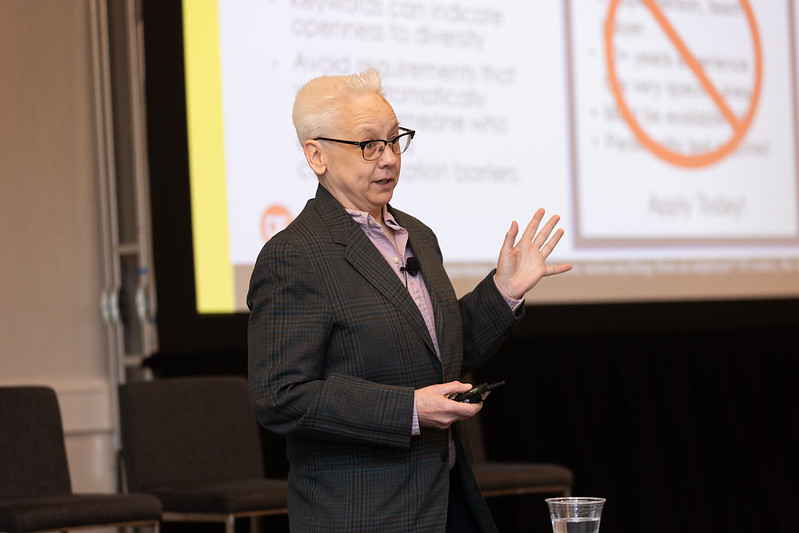 Bev offered the following website containing three and one-half days of free training for autism-informed employers to aid them in understanding the recruitment, employment, and retention of autistic employees: https://www.hdilearning.org/. Then she provided the following tips:
Bev offered the following website containing three and one-half days of free training for autism-informed employers to aid them in understanding the recruitment, employment, and retention of autistic employees: https://www.hdilearning.org/. Then she provided the following tips:
- “So, before the interview, you want to make sure things are set up right,” Bev suggested. “The sensory environment: you want it to be reasonably quiet and private. Fluorescent lighting in the long tubes is bad for everybody. But autistic people can find it painful. It’s really best to choose a place where you can disable the overhead lighting if it is like that and bring in lamps,” Bev added.
- “A lot of [autistic] people have difficulty with strong scents. You want a scent-free area and adequate space for moving around,” Bev said.
- “We need really clear expectations. We need to know what’s going on,” Bev reported. “A lot of times, the wording can be ambiguous. When there are rules to follow, autistic people do really well with being given rules and reasons. Without the reasons, you might find people balking at the rules. They have an idea of how it’s going to go and your contradiction of the rule without giving a reason will likely be confusing. So, you want a structure that people know how to follow and that is very clear, but also allows for some differences,” Bev cautioned.
- “If your website has a diversity statement, does that diversity statement include disability?” asked Bev. And on the disability side of the discussion, Bev added that: “If you don’t have people with disabilities pictured in your website, that’s a sign that this is maybe not the place where I will help somebody find a job,” Bev noted.
- “When you’re thinking about job descriptions and advertisements, there are keywords that will discourage or encourage a person with a disability, particularly a neurodivergent person. Every job description always seems to start off with ‘excellent communication skills required.’ Well, every job requires that, doesn’t it?” Bev questioned. “But if you understand about autism, then it may not be surprising that a person may know very much but not be able to always say it,” Bev observed.
- “The worst, absolute worst thing that happens to us when we’re looking for a job is the ‘personality inventory’”, Bev reported. “This is because autistic people so often read words literally. So, for example, if your personality inventory asks if the jobseeker had ever stolen anything from your employer, it throws the autistic jobseeker into panic wondering if the question seeks to know about the small value company pen or pencil the jobseeker took with her/him when s/he left the employment of a prior employer. So, think about the person who takes everything very literally like that. It’s not always something that obvious,” intoned Bev.
- “Be clear about the location” (of the job interview),” Bev suggested. Bev reported that many autistic individuals (including herself) have great difficulty with spatial understanding and directions and thus have great difficulties with maps. Also, online maps and directions may be out of date and show parking garages that no longer exist or are temporarily closed. Be very specific as to the precise location and how to walk that last one hundred yards to the interview room.
- “And make sure that you have a room that’s going to be sensory-friendly for your interview,” Bev strongly suggested. Accommodations that autistic jobseekers often seek are a support person to accompany them to the interview and to help them “if I get stuck (through sensory overload), if I need help with communication,” Bev noted.
- Bev wondered why more employers could not supply some or all the interview questions to the candidates in advance to help them get their thoughts in order. She reported that employers were more and more frequently supplying questions to Jobseekers in advance of the interviews, at least for those jobs where experience was more important than thinking quickly on one’s feet. Bev also wondered if more employers could change their practices to allow for written Jobseeker responses to the job interview questions. Bev explained that this would allow any ensuing in-person interview to focus more specifically on specific aspects of the employer’s prior work history and experience and play to the autistic Jobseeker’s preference for specificity rather than broad open-ended questions.
- “Meeting with one interviewer is so much easier than meeting with a panel or several people (all at once),” Bev suggested. And, if a Jobseeker has “both communication and social difficulties, trying to juggle a conversation with more than one person can be a bit too much for an autistic person,” she observed.
- To avoid eye-to-eye contact during Interviews which may be painful, Bev suggested that before the interview begins, the Interviewer simply re-arrange the chairs in the interview room to avoid causing the Jobseeker to sit directly across the table from the Interviewer. Perhaps the desk chairs could be arranged, Bev wondered, by placing one at the end of a table and placing the Interviewer in the middle of the table (or vice versa) sitting at 90 degrees to the Jobseeker. Bev also suggested that interviewers occupy an interview space sufficiently large to allow an autistic jobseeker to walk around and invite him/her to do so throughout the interview (to help avoid potentially disruptive and/or painful eye contact).
- Bev suggested that Interviewers should not ask compound, ambiguous, or open-ended interview questions. All of these poorly formed interview questions will throw many autistic Jobseekers into a sensory overload as s/he hunts through dictionaries of possible answers to the question in the Jobseeker’s brain causing the Jobseeker to get potentially “stuck trying to sort the question and (the many possible) answers available to the autistic Jobseeker.”“The communication that works for autistic people across the board is clear, concise, and consistent. You might think you are being clear, sometimes, but we might need more detail. We need things to be logical and/or meaningful. And if you want an autistic person to like you or follow your direction, all you have to do is show them some respect. Because I guarantee you this person is so starved for that that they are going to connect well with you when you show them just the slightest bit of respect that you would otherwise show to most human beings,” Bev said.
- “The most important accommodation you can grant is to just slow down. Give us a bit more time. And don’t be too impatient,” Bev suggested. Bev also suggested in lieu of talking, often the autistic Jobseeker’s weakest skill, that you ask for a demonstration of their skills. Perhaps give them a problem to solve. In conjunction with that tip, Bev also recommends that interviewers signal, through their language, that they are now moving to a different topic of inquiry during the interview. This signaling will give the autistic Jobseeker a moment and chance to understand that the previous line of inquiry is concluded and to reset, reboot, and prepare for another different line of questioning.”
Panel Discussion: Steering the NLx
 The National Labor Exchange (“NLx”) Steering Committee is the premier nonprofit labor exchange system in the United States, established in 2007 through a partnership between the National Association of State Workforce Agencies (“NASWA”) and DirectEmployers Association (“DE”). It leverages its technology, data, expertise, and networks to help build connectivity between workers, employers, government agencies, and nonprofit organizations to provide economic opportunity, recruitment assistance, and workforce development support. This trusted workforce system resource runs like a well-oiled machine thanks to its appointed steering committee – a group of employer and state workforce agency representatives, along with NASWA and DirectEmployers staff – responsible to establish the strategy of the NLx and ensure its offerings deliver value.
The National Labor Exchange (“NLx”) Steering Committee is the premier nonprofit labor exchange system in the United States, established in 2007 through a partnership between the National Association of State Workforce Agencies (“NASWA”) and DirectEmployers Association (“DE”). It leverages its technology, data, expertise, and networks to help build connectivity between workers, employers, government agencies, and nonprofit organizations to provide economic opportunity, recruitment assistance, and workforce development support. This trusted workforce system resource runs like a well-oiled machine thanks to its appointed steering committee – a group of employer and state workforce agency representatives, along with NASWA and DirectEmployers staff – responsible to establish the strategy of the NLx and ensure its offerings deliver value.
Amber Gaither, Director of the NLx, and Lori Adams, Senior Policy Director at NASWA, led a panel discussion with three fellow Steering Committee members: (1) Brian Pier, Director Of Compliance at Levi, Ray & Shoup, Inc. (LRS), (2) Nesha Christian-Hendrickson, Assistant Commissioner/Legal Counsel at Virgin Islands Department of Labor, and (3) Luz Cuevas- Santos, CCDP Diversity and Inclusion Advisor at Canon USA
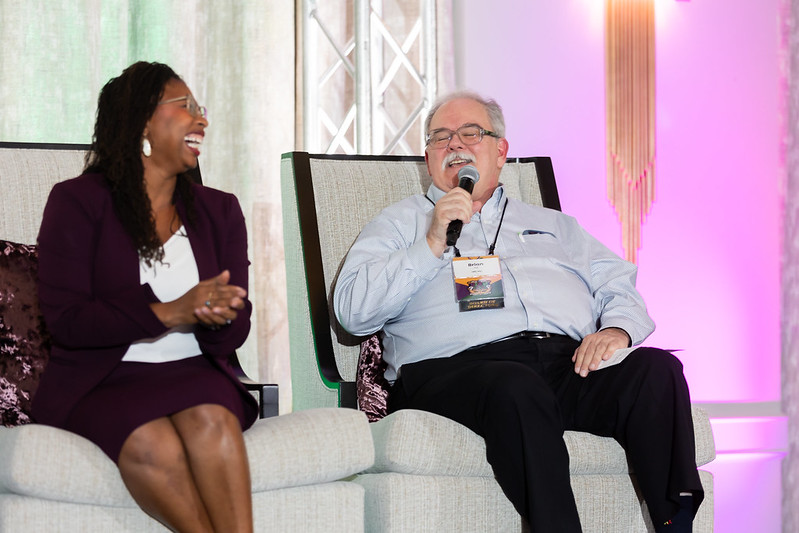 The Steering Committee meets annually and consists of six DE members, representing the employer community, and six NASWA members, representing the workforce system and workers. Its members communicate priorities, provide feedback, review projects, offer subject matter expertise, and share promising practices.
The Steering Committee meets annually and consists of six DE members, representing the employer community, and six NASWA members, representing the workforce system and workers. Its members communicate priorities, provide feedback, review projects, offer subject matter expertise, and share promising practices.
The panel answered questions and talked about how they appreciated the exchange of ideas within the committee. They discussed some of its recent accomplishments and encouraged the audience to consider serving on the committee. In addition, they told the audience that they could find out more by stopping by the NLx booth at the conference, or otherwise contacting any committee member.
Long’s Keynote: Connecting the Workplace & Life Through FUN
 Speaker, author, and podcaster Paul J. Long generated the FUN to close out the day. Paul brought his enthusiastic and humorous energy, leveraging his concept of “FUNdamism,” to deliver a unique keynote address with tactical tips to create more meaningful interactions with others.
Speaker, author, and podcaster Paul J. Long generated the FUN to close out the day. Paul brought his enthusiastic and humorous energy, leveraging his concept of “FUNdamism,” to deliver a unique keynote address with tactical tips to create more meaningful interactions with others.
While FUN can be defined differently for all individuals, Paul’s core beliefs and “FUNdamism” are based on the following acronym:
Foundation – The first step in maximizing fulfillment is through self-reflection and identifying everything that makes you, YOU. “This is our DNA, our experience in life, our communication style,” he said. How we experience our life is the only thing we can really control. “It is the only thing that we can change or influence. It starts with our foundation.”
“Once we identify our foundation, we accept who we are, and we work on our opportunity gaps, then and only then, can we move on” to the next step, understanding others’ perspectives.
Understanding Others’ Perspectives – Understanding the perspective of others will improve the probability of success in creating professional and personal fulfillment. “It is not about agreeing with everybody, but about listening and understanding their perspective and giving it time and seeing if we have any common ground,” he explained. Then we can move on to the next steps.
Next Steps – Next steps are the tactical behaviors – or FUNdamentals – that will help maximize fulfillment both at work and home.
He started by introducing the concept of “Brain Pattern Interrupt.” That is “an experience that serves to alter a person’s mental, emotional, or behavioral state. Also described as an unexpected act that thrusts individuals into another state of mind.” This type of experience serves to get a person out of their head and into the moment, Paul explained. Brain Pattern Interrupt is one way to “keep bad moments from becoming bad days,” he stated.
“Energy flows where attention goes,” Paul said, quoting Tony Robbins. “When we are having bad days, what do you see more of? Bad stuff, right?” This bad energy means that “[w]e are so laser-focused on what is not working, that we cannot clearly see what is,” he pointed out.
Paul gave several examples of Brain Pattern Interrupt from his own experiences and had the audience team up and exchange in an exercise with this instruction: “Rather than asking the question how is it going today? What if we were more deliberate in creating an environment where people had to force themselves to think about something that could potentially make them smile, like what is one good thing that has happened to you or for you in the last two weeks?”
Following the exercise, he noted that while it is fairly easy for someone to think of one good thing in this context, it is often difficult to think of more than one good thing. In contrast, “[i]f I was to ask you what was challenging in your day-to-day, what went awry in your day today? What is going on at work right now that you are missing that is blowing up? How many things would just roll off your tongue?” he asked, noting that most people could identify many such things. “Why have we normalized [focusing] on what is not working as opposed to what is? Answer: because we have allowed ourselves to,” he pointed out.
Currently in HR “we are trying to attract the right talent. We are trying to develop said talent and we are trying to sustain great talent all while looking for ways to engage with a workforce or customers that quite honestly sometimes feel like they do not want to engage,” Paul pointed out.
He continued:
“We all know that there are individuals in your organization that will suck your energy dry. And you give and you give and you give and you give and you agree upon a solid strategy to move past whatever this roadblock is and then it is still there! And then you say, ‘What did you do as a result of our conversation?” and they say, ‘Why? What conversation?’ At what point do we have to stop pouring our energy into people who are not willing to pour energy into themselves? Please hear me. I am not saying do not help people that need help. But what I am saying is that you have to help yourself first. You have to have the energy to give. And what I know is everybody in this room has gone through something, is currently going through something, or will inevitably go through something. So, our goal should always be how do we get ourselves out of our heads and into the moment?”
Paul then provided a few of his favorite ways to do that through the FUNamentals of FUNdamism. He also shared a QR code that went to his Linktree, which includes a link to a free 102-page workbook that has 117 fundamentals, a.k.a., Brain Pattern Interrupts. “You can create your own implementation strategy and walk out of this room today and create a huddle for your employees tomorrow related to some way to get them out of their head and into the moment,” he said.
These tactical behaviors include:
 Create Meaningful Interactions – “Imagine we are so deliberate [that] we had a desired outcome in mind [every time] we interacted with somebody else. . . And it was as simple as this. How do I make somebody smile? Laugh? Or feel appreciated? Imagine that we were so deliberate every single time that we went into an interaction,” Paul pondered. That is one of the ways that he judges whether he has created a meaningful interaction, he said.
Create Meaningful Interactions – “Imagine we are so deliberate [that] we had a desired outcome in mind [every time] we interacted with somebody else. . . And it was as simple as this. How do I make somebody smile? Laugh? Or feel appreciated? Imagine that we were so deliberate every single time that we went into an interaction,” Paul pondered. That is one of the ways that he judges whether he has created a meaningful interaction, he said.
Telling someone you appreciate them is fine, but to create a meaningful interaction, you should go further, Paul advised. “Share what [they] are appreciated for, why it is important to you, and how it makes you feel . . . You want to attract better talent? You want to keep great talent in your organization? They better feel you. They better feel your emotional connection. And this is one way to do it. Making people feel appreciated by creating meaningful interactions,” he said.
Listen with Intent – “How many of us listen with intent to actually understand?” Paul asked. He elaborated:
“Oftentimes we listen with intent because we are problem solvers to solve the problem, right? But what if we listen to the same level of intent as our favorite standup comedians . . . [whom we listen to] with a very specific intent. What is my intent? To laugh. Simple as that . . . So, if we listen to stand-up comedy to laugh, if we listen to music to feel, to escape, to dance, to sing, what are we listening for to the individual right in front of us when we ask them that tired question, how was your day? Are we asking because we are genuinely curious, and we want to know the answer? Or are we just checking a box? Imagine if we were so deliberate listening with the intent to the person standing right in front of us as we are a favorite comedian or a favorite musician, life would change. And so will your experience on this earth.”
Embrace Awkward Moments – “This is all about leaning into who you are, your authentic spirit,” Paul said. “Doesn’t it make sense that we work our tail off at earning the respect that we see in the mirror and stop chasing the desire and appreciation of others?” he questioned. To illustrate he used the example of how he and a friend teamed up to become the “Cat Suit Guys,” wearing wrestling singlets depicting cat faces and sporting creative accessories to support the Kansas City Royals in their World Series quests in 2014 and 2015 (the Royals first post-season appearances since 1985). “I said I would do it on one condition, and one condition only, we have to call ourselves ‘The Designated Litter,’” he quipped. When asked about why he was doing that, he responded, “Somebody once told me, ‘Do not worry what people think about you, because they don’t think about you.’” He continued, “What I am saying is that as you are up for a promotional opportunity or a prospect call or maybe you are exploring a job change, maybe you’re just thinking about singing in front of someone else. Nobody is thinking about you more than you.”
He concluded:
“So, make a commitment to embrace awkward moments. Make a commitment to listen with genuine intent and to create more meaningful interactions forcing people to smile, laugh, or feel appreciated through Brain Pattern Interrupts. And if you do that, I promise you your life will open up. You will retain better talent. You will attract better talent and most importantly, you will be happy.”
And everyone in the audience left happy!
Day 2 Recap
THIS COLUMN IS MEANT TO ASSIST IN A GENERAL UNDERSTANDING OF THE CURRENT LAW AND PRACTICE RELATING TO OFCCP. IT IS NOT TO BE REGARDED AS LEGAL ADVICE. COMPANIES OR INDIVIDUALS WITH PARTICULAR QUESTIONS SHOULD SEEK ADVICE OF COUNSEL.
SUBSCRIBE.
Compliance Alerts
Compliance Tips
Week In Review (WIR)
Subscribe to receive alerts, news and updates on all things related to OFCCP compliance as it applies to federal contractors.
OFCCP Compliance Text Alerts
Get OFCCP compliance alerts on your cell phone. Text the word compliance to 18668693326 and confirm your subscription. Provider message and data rates may apply.
- OFCCP Week In Review: April 29, 2024 - April 29, 2024
- OFCCP Week in Review Special Edition | DEAMcon24 Day Two Recap - April 24, 2024
- OFCCP Week In Review: April 22, 2024 - April 22, 2024
- OFCCP Week in Review Special Edition | DEAMcon24 Day Three Recap - April 29, 2024
- GAMECHANGER: OFCCP Proposed Changes to Construction Compliance Review Scheduling Letter, Itemized Listing, and Construction Contract Award Notification Requirement Form - February 26, 2024
- Carnegie-Mellon Researchers Published Report on Statistical Uncertainty in Census Bureau Data - September 12, 2022
- Biden Administration DOL Publishes Final Rule Rescinding Trump Administration Independent Contractor Rule Under the FLSA - May 10, 2021
- OFCCP’s New MOU with the EEOC Could Dramatically Change OFCCP’s Enforcement Program - November 9, 2020
- Section 3610 of the CARES Act Provides Potential Additional Relief for Qualified Federal Contractors - April 6, 2020


Petersen Provided Insights on Creating a Socially Just Recruitment Strategy
Understanding the Social Landscape
Cheryl first reviewed the landscape. Technological advancements are reshaping communication, collaboration, and work patterns, she noted. “It’s imperative for organizations [to] adapt to their recruitment practices” to meet the constantly changing needs and expectations of the workforce,” she said.
Importance of Social Justice in Recruitment
At Arup, “we define social justice [as] the practice of ensuring fairness, equity, and inclusivity throughout the hiring process,” Cheryl said. This effort involves actively identifying and addressing biases, barriers, and systemic inequalities that may disproportionately impact certain individuals or groups. “When we talk about barriers” the focus is on barriers that all types of job seekers may have to joining Arup, she said. The importance of social justice in recruitment lies in its ability to foster diversity, create equal opportunities, and build a more inclusive workforce, she pointed out.
Building a Socially Just Recruitment Strategy
Cheryl explained that to build a socially just recruitment strategy, an organization must first assess current practices by implementing the following steps:
In this process, Cheryl tries to focus her recruiting team on actively listening. Because many recruiters are uncomfortable having these important conversations with hiring managers, they engage in role-playing exercises. She gave multiple other examples of how Arup engages in the above steps.
Employers should also consider how they leverage technology for fair hiring, Cheryl advised. When using AI, organizations should consider how to minimize bias and enhance fairness, analyze large volumes of candidate data objectively, identify patterns in hiring decisions, and highlight potential areas for improvement.
Furthermore, employers should implement a recruitment process that removes identifying information from resumes, minimizes the influence of unconscious bias in the initial screening stages, and evaluates candidates based solely on skills, qualifications, and experience.
Showcasing Your Organizational Commitment
“When I talk about showcasing, this is not showboating,” Cheryl said. “This is a very humble approach that you need to take, but you need to be proud of what you’ve done as an organization. It is a long journey. It doesn’t end. We don’t suddenly arrive at a place [where] I tell my teams that we’ve made it,” she continued.
Ways an employer can showcase organizational commitment include:
Keys to Success
Cheryl summarized three key points. First, prioritize fairness, transparency, and inclusivity at every stage of the hiring process. “Sometimes we can get myopic and we have our own biases and our own insecurities about what we’re doing … All it takes is somebody else challenging you a little bit to really make that progress,” she advised.
Second, be proactive, adaptable, and committed to creating a socially just recruitment strategy. “There’s a community out there” and recruiters should join forums and otherwise speak to other recruiters to compare what they are doing and share best practices and challenges, Cheryl recommended.
Third, and most importantly, listen to your candidates and employees. “I can’t stress that enough,” Cheryl said. Make sure that “you’re listening and engaging with them and understanding what their needs are and talking to your communities to understand,” she added.